Pictorial Learning Journal for Construction Site Preparation and Building Techniques
VerifiedAdded on 2023/06/13
|36
|3220
|251
AI Summary
This pictorial learning journal covers various aspects of construction site preparation and building techniques, including site preparation, excavation, concrete, brickwork, framing, carpentry, roof cladding, interior linings, windows and doors, and services. It provides detailed information on each topic with illustrations and diagrams.
Contribute Materials
Your contribution can guide someone’s learning journey. Share your
documents today.
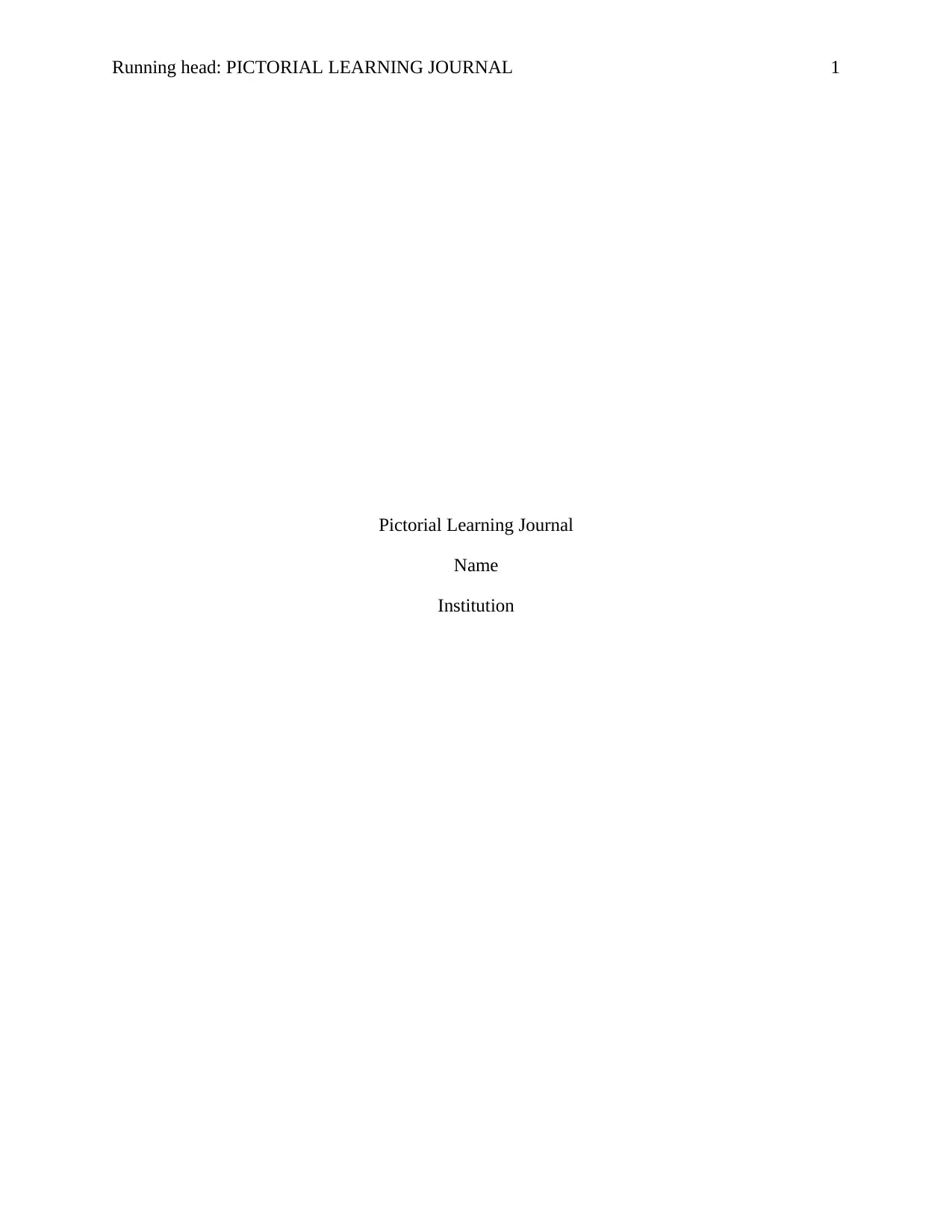
Running head: PICTORIAL LEARNING JOURNAL 1
Pictorial Learning Journal
Name
Institution
Pictorial Learning Journal
Name
Institution
Secure Best Marks with AI Grader
Need help grading? Try our AI Grader for instant feedback on your assignments.
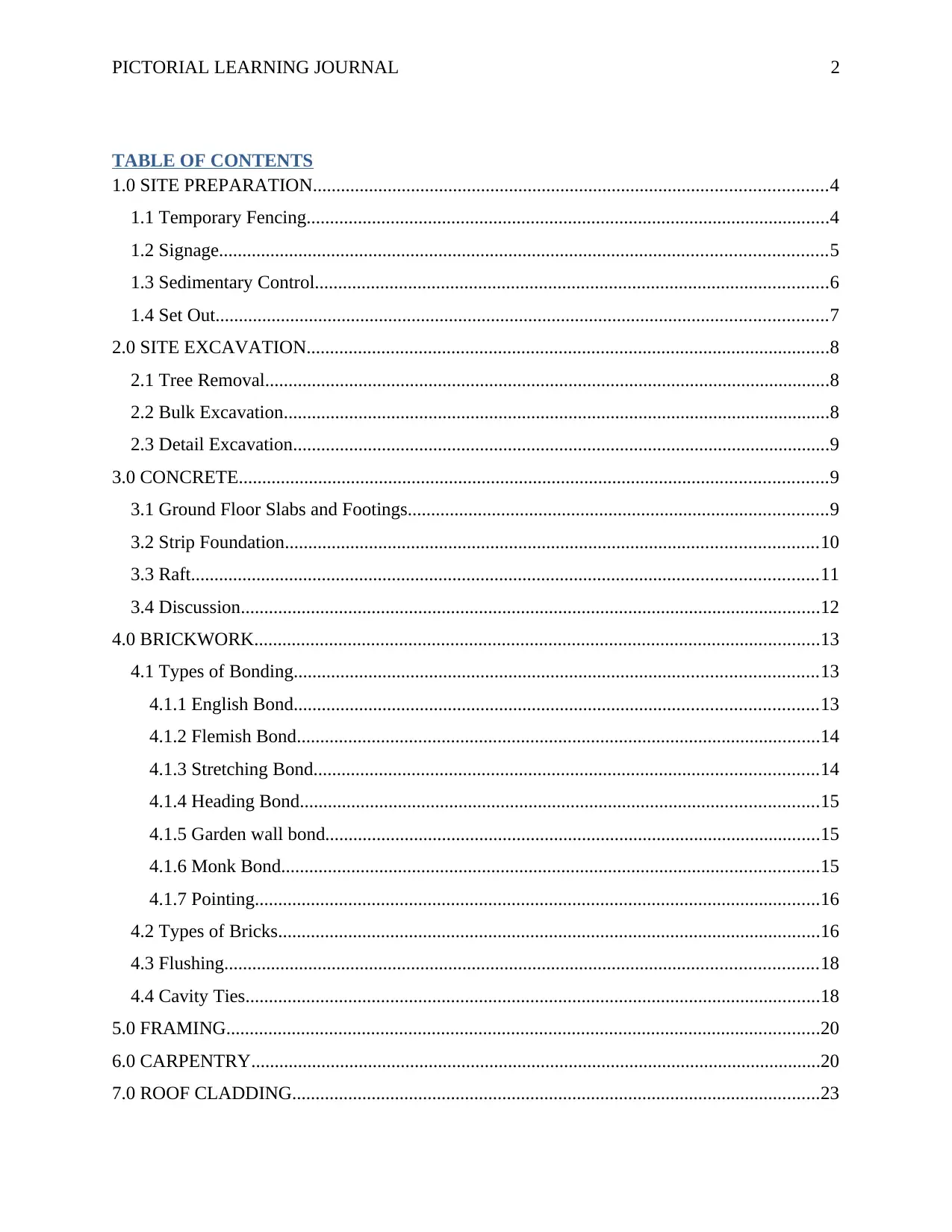
PICTORIAL LEARNING JOURNAL 2
TABLE OF CONTENTS
1.0 SITE PREPARATION..............................................................................................................4
1.1 Temporary Fencing................................................................................................................4
1.2 Signage..................................................................................................................................5
1.3 Sedimentary Control..............................................................................................................6
1.4 Set Out...................................................................................................................................7
2.0 SITE EXCAVATION................................................................................................................8
2.1 Tree Removal.........................................................................................................................8
2.2 Bulk Excavation.....................................................................................................................8
2.3 Detail Excavation...................................................................................................................9
3.0 CONCRETE..............................................................................................................................9
3.1 Ground Floor Slabs and Footings..........................................................................................9
3.2 Strip Foundation..................................................................................................................10
3.3 Raft......................................................................................................................................11
3.4 Discussion............................................................................................................................12
4.0 BRICKWORK.........................................................................................................................13
4.1 Types of Bonding................................................................................................................13
4.1.1 English Bond................................................................................................................13
4.1.2 Flemish Bond................................................................................................................14
4.1.3 Stretching Bond............................................................................................................14
4.1.4 Heading Bond...............................................................................................................15
4.1.5 Garden wall bond..........................................................................................................15
4.1.6 Monk Bond...................................................................................................................15
4.1.7 Pointing.........................................................................................................................16
4.2 Types of Bricks....................................................................................................................16
4.3 Flushing...............................................................................................................................18
4.4 Cavity Ties...........................................................................................................................18
5.0 FRAMING...............................................................................................................................20
6.0 CARPENTRY..........................................................................................................................20
7.0 ROOF CLADDING.................................................................................................................23
TABLE OF CONTENTS
1.0 SITE PREPARATION..............................................................................................................4
1.1 Temporary Fencing................................................................................................................4
1.2 Signage..................................................................................................................................5
1.3 Sedimentary Control..............................................................................................................6
1.4 Set Out...................................................................................................................................7
2.0 SITE EXCAVATION................................................................................................................8
2.1 Tree Removal.........................................................................................................................8
2.2 Bulk Excavation.....................................................................................................................8
2.3 Detail Excavation...................................................................................................................9
3.0 CONCRETE..............................................................................................................................9
3.1 Ground Floor Slabs and Footings..........................................................................................9
3.2 Strip Foundation..................................................................................................................10
3.3 Raft......................................................................................................................................11
3.4 Discussion............................................................................................................................12
4.0 BRICKWORK.........................................................................................................................13
4.1 Types of Bonding................................................................................................................13
4.1.1 English Bond................................................................................................................13
4.1.2 Flemish Bond................................................................................................................14
4.1.3 Stretching Bond............................................................................................................14
4.1.4 Heading Bond...............................................................................................................15
4.1.5 Garden wall bond..........................................................................................................15
4.1.6 Monk Bond...................................................................................................................15
4.1.7 Pointing.........................................................................................................................16
4.2 Types of Bricks....................................................................................................................16
4.3 Flushing...............................................................................................................................18
4.4 Cavity Ties...........................................................................................................................18
5.0 FRAMING...............................................................................................................................20
6.0 CARPENTRY..........................................................................................................................20
7.0 ROOF CLADDING.................................................................................................................23

PICTORIAL LEARNING JOURNAL 3
8.0 INTERIOR LININGS..............................................................................................................25
8.1 Plaster Board........................................................................................................................25
8.2 Tiling....................................................................................................................................25
9.0 WINDOWS AND DOORS.....................................................................................................26
10.0 SERVICES............................................................................................................................28
8.0 INTERIOR LININGS..............................................................................................................25
8.1 Plaster Board........................................................................................................................25
8.2 Tiling....................................................................................................................................25
9.0 WINDOWS AND DOORS.....................................................................................................26
10.0 SERVICES............................................................................................................................28
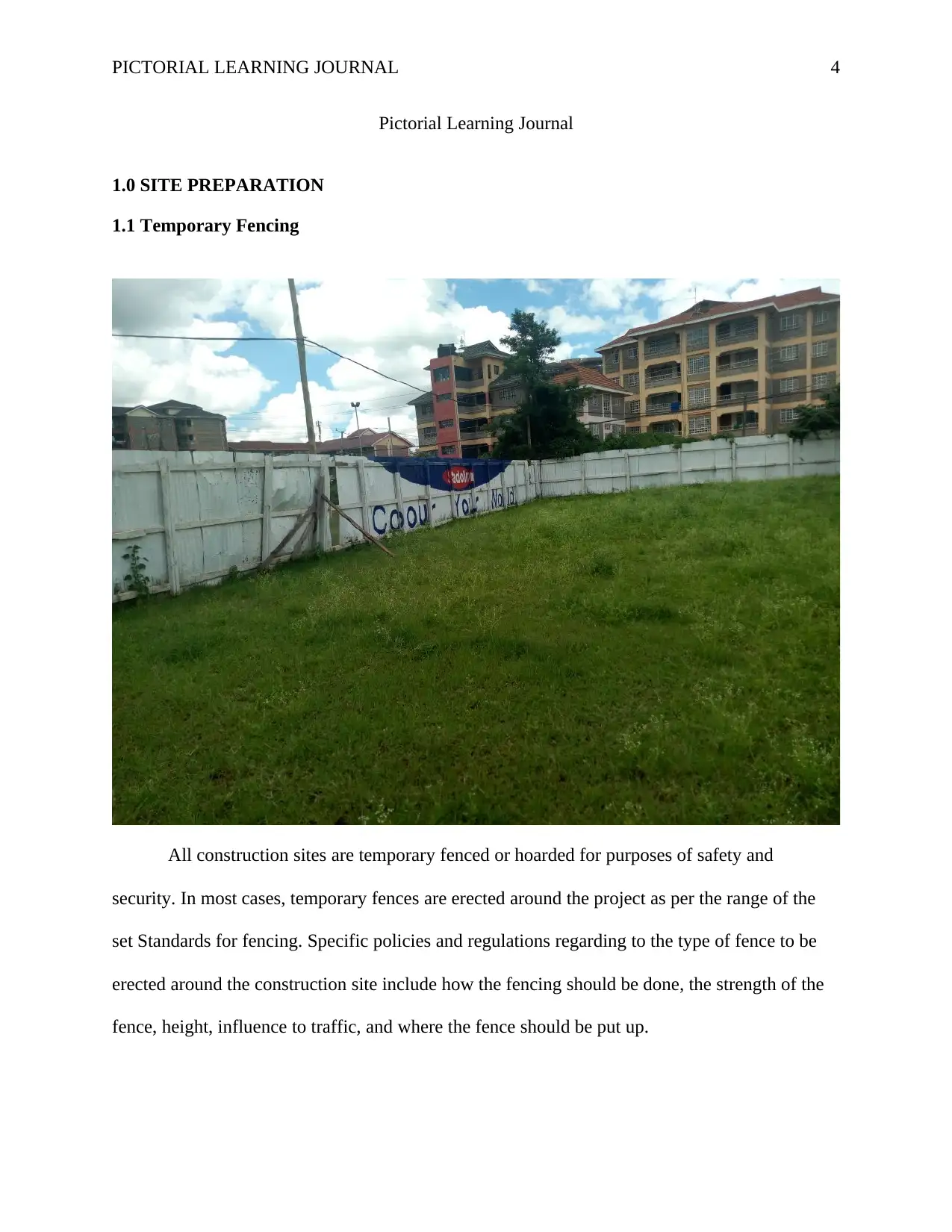
PICTORIAL LEARNING JOURNAL 4
Pictorial Learning Journal
1.0 SITE PREPARATION
1.1 Temporary Fencing
All construction sites are temporary fenced or hoarded for purposes of safety and
security. In most cases, temporary fences are erected around the project as per the range of the
set Standards for fencing. Specific policies and regulations regarding to the type of fence to be
erected around the construction site include how the fencing should be done, the strength of the
fence, height, influence to traffic, and where the fence should be put up.
Pictorial Learning Journal
1.0 SITE PREPARATION
1.1 Temporary Fencing
All construction sites are temporary fenced or hoarded for purposes of safety and
security. In most cases, temporary fences are erected around the project as per the range of the
set Standards for fencing. Specific policies and regulations regarding to the type of fence to be
erected around the construction site include how the fencing should be done, the strength of the
fence, height, influence to traffic, and where the fence should be put up.
Secure Best Marks with AI Grader
Need help grading? Try our AI Grader for instant feedback on your assignments.
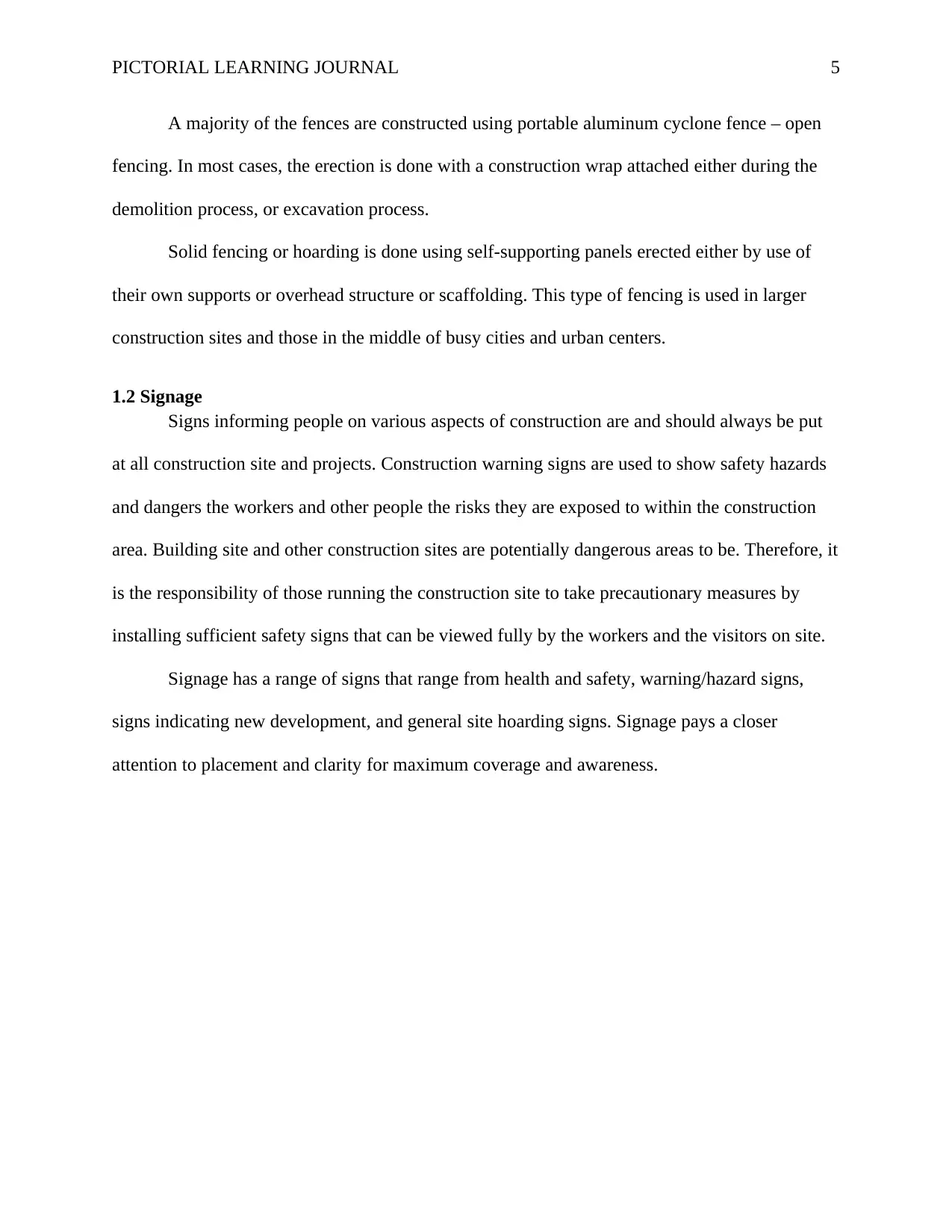
PICTORIAL LEARNING JOURNAL 5
A majority of the fences are constructed using portable aluminum cyclone fence – open
fencing. In most cases, the erection is done with a construction wrap attached either during the
demolition process, or excavation process.
Solid fencing or hoarding is done using self-supporting panels erected either by use of
their own supports or overhead structure or scaffolding. This type of fencing is used in larger
construction sites and those in the middle of busy cities and urban centers.
1.2 Signage
Signs informing people on various aspects of construction are and should always be put
at all construction site and projects. Construction warning signs are used to show safety hazards
and dangers the workers and other people the risks they are exposed to within the construction
area. Building site and other construction sites are potentially dangerous areas to be. Therefore, it
is the responsibility of those running the construction site to take precautionary measures by
installing sufficient safety signs that can be viewed fully by the workers and the visitors on site.
Signage has a range of signs that range from health and safety, warning/hazard signs,
signs indicating new development, and general site hoarding signs. Signage pays a closer
attention to placement and clarity for maximum coverage and awareness.
A majority of the fences are constructed using portable aluminum cyclone fence – open
fencing. In most cases, the erection is done with a construction wrap attached either during the
demolition process, or excavation process.
Solid fencing or hoarding is done using self-supporting panels erected either by use of
their own supports or overhead structure or scaffolding. This type of fencing is used in larger
construction sites and those in the middle of busy cities and urban centers.
1.2 Signage
Signs informing people on various aspects of construction are and should always be put
at all construction site and projects. Construction warning signs are used to show safety hazards
and dangers the workers and other people the risks they are exposed to within the construction
area. Building site and other construction sites are potentially dangerous areas to be. Therefore, it
is the responsibility of those running the construction site to take precautionary measures by
installing sufficient safety signs that can be viewed fully by the workers and the visitors on site.
Signage has a range of signs that range from health and safety, warning/hazard signs,
signs indicating new development, and general site hoarding signs. Signage pays a closer
attention to placement and clarity for maximum coverage and awareness.

PICTORIAL LEARNING JOURNAL 6
1.3 Sedimentary Control
Controlling of sedimentation and erosion on construction sites should be done prior,
during and after the construction process to prevent problems such as uneven settlement.
Sedimentation control can be done temporarily or permanently depending on the nature of
construction taking place. Controlling sedimentation also limits the amount of sediments carried
into lakes and streams.
Sedimentation control can be done through several methods including erection of silt
fences, use of fiber logs, rock construction entrances, grade breaks, erosion control blankets,
temporary sedimentation blankets, filter bags, etc. All these methodologies work through the
1.3 Sedimentary Control
Controlling of sedimentation and erosion on construction sites should be done prior,
during and after the construction process to prevent problems such as uneven settlement.
Sedimentation control can be done temporarily or permanently depending on the nature of
construction taking place. Controlling sedimentation also limits the amount of sediments carried
into lakes and streams.
Sedimentation control can be done through several methods including erection of silt
fences, use of fiber logs, rock construction entrances, grade breaks, erosion control blankets,
temporary sedimentation blankets, filter bags, etc. All these methodologies work through the
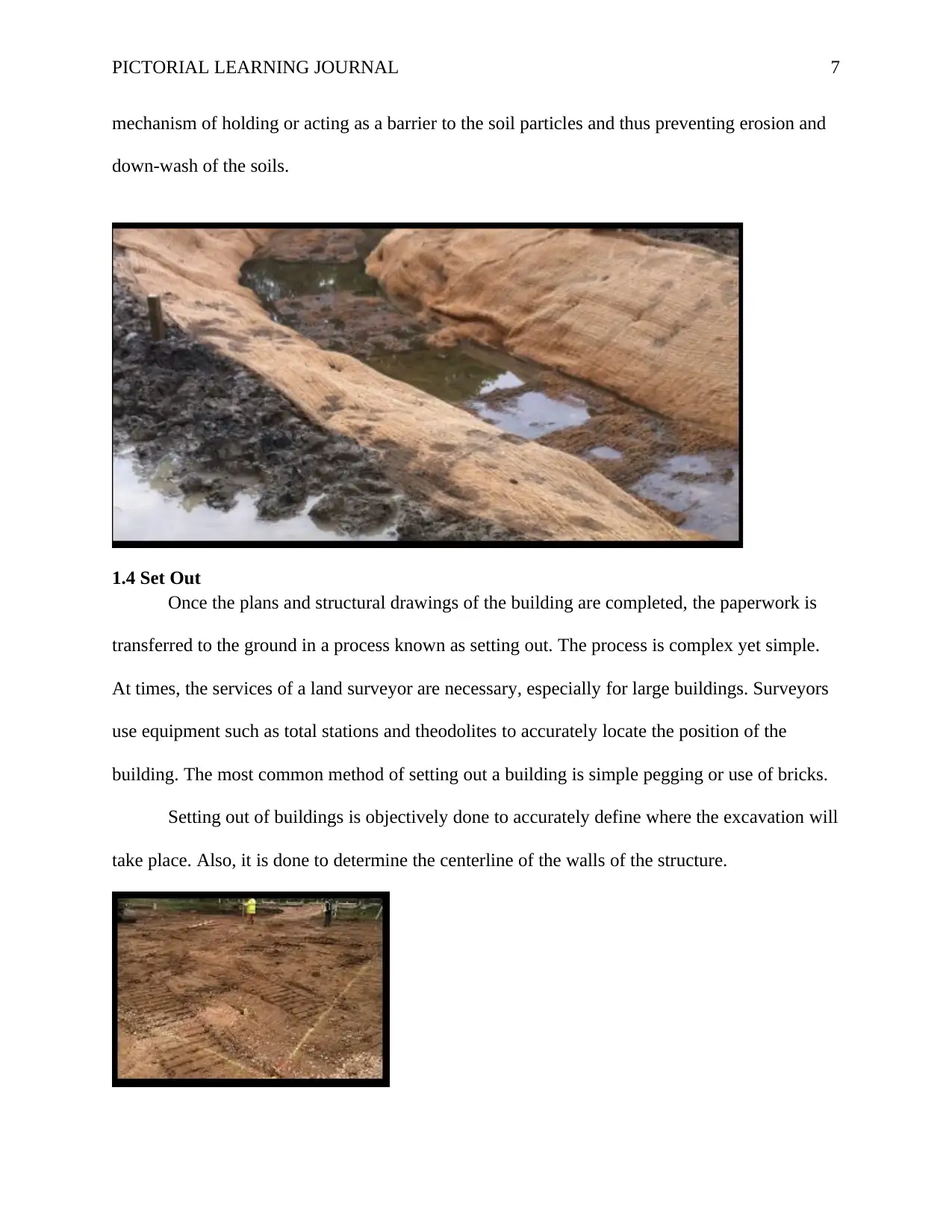
PICTORIAL LEARNING JOURNAL 7
mechanism of holding or acting as a barrier to the soil particles and thus preventing erosion and
down-wash of the soils.
1.4 Set Out
Once the plans and structural drawings of the building are completed, the paperwork is
transferred to the ground in a process known as setting out. The process is complex yet simple.
At times, the services of a land surveyor are necessary, especially for large buildings. Surveyors
use equipment such as total stations and theodolites to accurately locate the position of the
building. The most common method of setting out a building is simple pegging or use of bricks.
Setting out of buildings is objectively done to accurately define where the excavation will
take place. Also, it is done to determine the centerline of the walls of the structure.
mechanism of holding or acting as a barrier to the soil particles and thus preventing erosion and
down-wash of the soils.
1.4 Set Out
Once the plans and structural drawings of the building are completed, the paperwork is
transferred to the ground in a process known as setting out. The process is complex yet simple.
At times, the services of a land surveyor are necessary, especially for large buildings. Surveyors
use equipment such as total stations and theodolites to accurately locate the position of the
building. The most common method of setting out a building is simple pegging or use of bricks.
Setting out of buildings is objectively done to accurately define where the excavation will
take place. Also, it is done to determine the centerline of the walls of the structure.
Paraphrase This Document
Need a fresh take? Get an instant paraphrase of this document with our AI Paraphraser
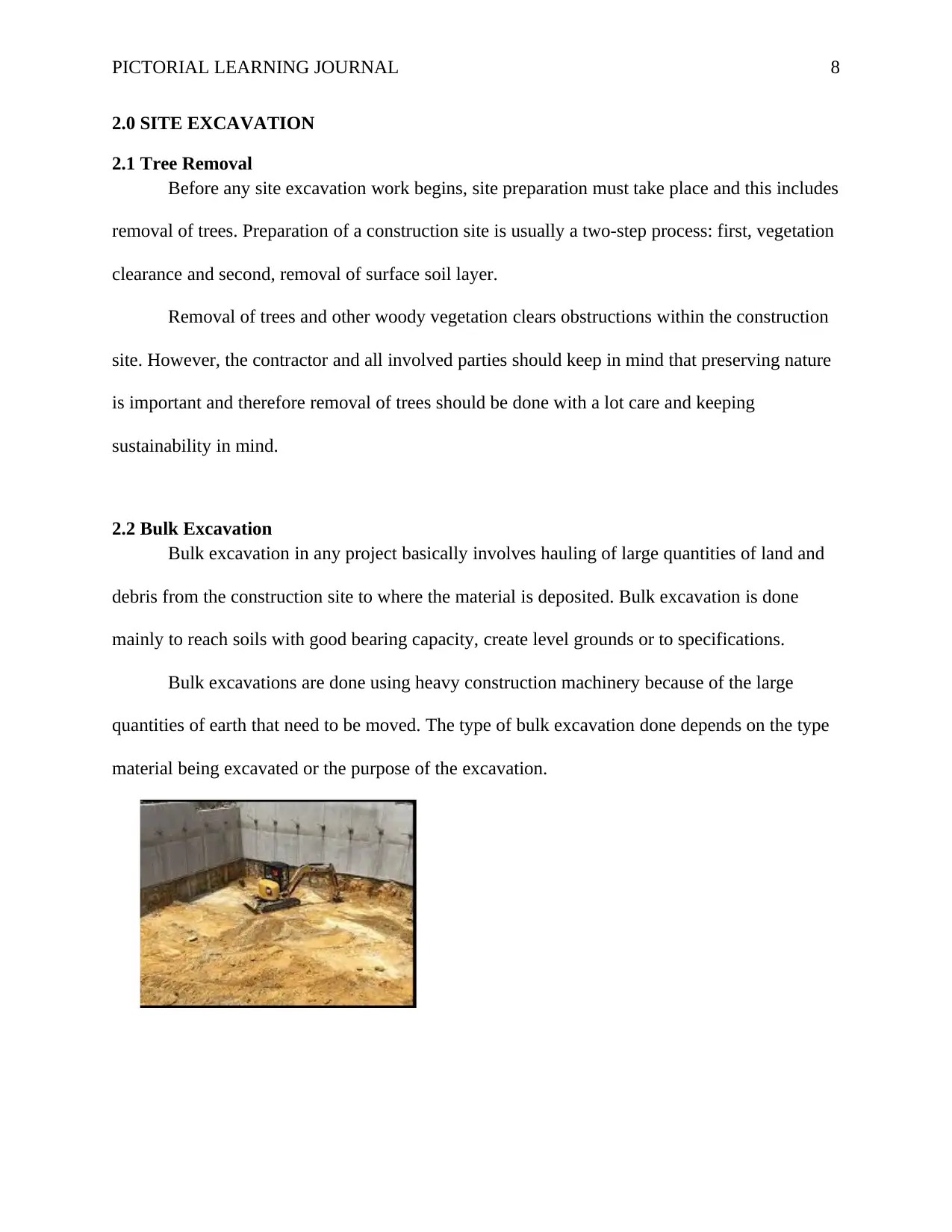
PICTORIAL LEARNING JOURNAL 8
2.0 SITE EXCAVATION
2.1 Tree Removal
Before any site excavation work begins, site preparation must take place and this includes
removal of trees. Preparation of a construction site is usually a two-step process: first, vegetation
clearance and second, removal of surface soil layer.
Removal of trees and other woody vegetation clears obstructions within the construction
site. However, the contractor and all involved parties should keep in mind that preserving nature
is important and therefore removal of trees should be done with a lot care and keeping
sustainability in mind.
2.2 Bulk Excavation
Bulk excavation in any project basically involves hauling of large quantities of land and
debris from the construction site to where the material is deposited. Bulk excavation is done
mainly to reach soils with good bearing capacity, create level grounds or to specifications.
Bulk excavations are done using heavy construction machinery because of the large
quantities of earth that need to be moved. The type of bulk excavation done depends on the type
material being excavated or the purpose of the excavation.
2.0 SITE EXCAVATION
2.1 Tree Removal
Before any site excavation work begins, site preparation must take place and this includes
removal of trees. Preparation of a construction site is usually a two-step process: first, vegetation
clearance and second, removal of surface soil layer.
Removal of trees and other woody vegetation clears obstructions within the construction
site. However, the contractor and all involved parties should keep in mind that preserving nature
is important and therefore removal of trees should be done with a lot care and keeping
sustainability in mind.
2.2 Bulk Excavation
Bulk excavation in any project basically involves hauling of large quantities of land and
debris from the construction site to where the material is deposited. Bulk excavation is done
mainly to reach soils with good bearing capacity, create level grounds or to specifications.
Bulk excavations are done using heavy construction machinery because of the large
quantities of earth that need to be moved. The type of bulk excavation done depends on the type
material being excavated or the purpose of the excavation.
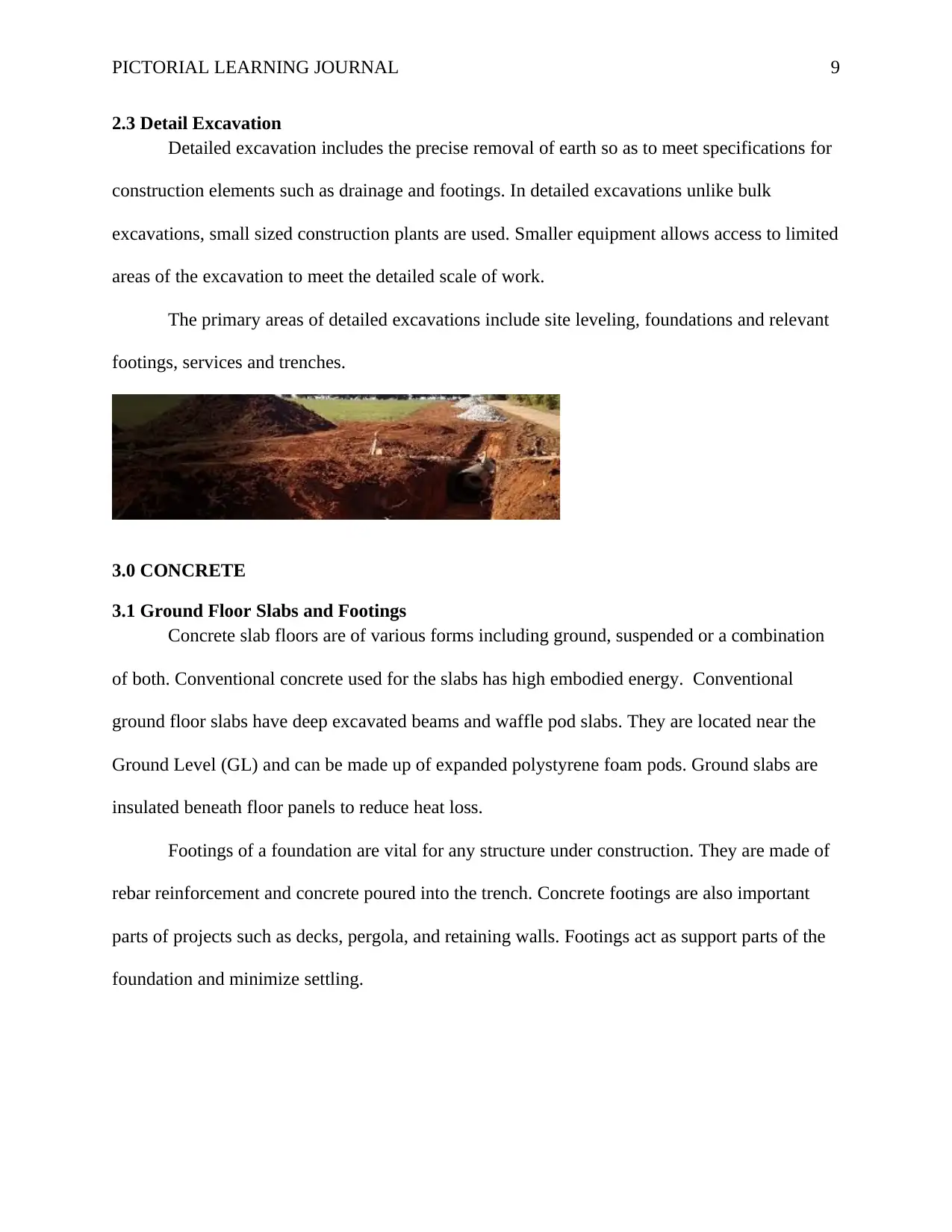
PICTORIAL LEARNING JOURNAL 9
2.3 Detail Excavation
Detailed excavation includes the precise removal of earth so as to meet specifications for
construction elements such as drainage and footings. In detailed excavations unlike bulk
excavations, small sized construction plants are used. Smaller equipment allows access to limited
areas of the excavation to meet the detailed scale of work.
The primary areas of detailed excavations include site leveling, foundations and relevant
footings, services and trenches.
3.0 CONCRETE
3.1 Ground Floor Slabs and Footings
Concrete slab floors are of various forms including ground, suspended or a combination
of both. Conventional concrete used for the slabs has high embodied energy. Conventional
ground floor slabs have deep excavated beams and waffle pod slabs. They are located near the
Ground Level (GL) and can be made up of expanded polystyrene foam pods. Ground slabs are
insulated beneath floor panels to reduce heat loss.
Footings of a foundation are vital for any structure under construction. They are made of
rebar reinforcement and concrete poured into the trench. Concrete footings are also important
parts of projects such as decks, pergola, and retaining walls. Footings act as support parts of the
foundation and minimize settling.
2.3 Detail Excavation
Detailed excavation includes the precise removal of earth so as to meet specifications for
construction elements such as drainage and footings. In detailed excavations unlike bulk
excavations, small sized construction plants are used. Smaller equipment allows access to limited
areas of the excavation to meet the detailed scale of work.
The primary areas of detailed excavations include site leveling, foundations and relevant
footings, services and trenches.
3.0 CONCRETE
3.1 Ground Floor Slabs and Footings
Concrete slab floors are of various forms including ground, suspended or a combination
of both. Conventional concrete used for the slabs has high embodied energy. Conventional
ground floor slabs have deep excavated beams and waffle pod slabs. They are located near the
Ground Level (GL) and can be made up of expanded polystyrene foam pods. Ground slabs are
insulated beneath floor panels to reduce heat loss.
Footings of a foundation are vital for any structure under construction. They are made of
rebar reinforcement and concrete poured into the trench. Concrete footings are also important
parts of projects such as decks, pergola, and retaining walls. Footings act as support parts of the
foundation and minimize settling.

PICTORIAL LEARNING JOURNAL 10
3.2 Strip Foundation
In construction sites with soils that have good bearing capacity, strip foundations are the
most suitable. Strip foundations have same sizes as the concrete cavity walls or the timber frame
cavity walls. The width of the wall and the strip size and position are directly related. While
concreting strip foundations, steel reinforcement is included to strengthen the foundation.
3.2 Strip Foundation
In construction sites with soils that have good bearing capacity, strip foundations are the
most suitable. Strip foundations have same sizes as the concrete cavity walls or the timber frame
cavity walls. The width of the wall and the strip size and position are directly related. While
concreting strip foundations, steel reinforcement is included to strengthen the foundation.
Secure Best Marks with AI Grader
Need help grading? Try our AI Grader for instant feedback on your assignments.
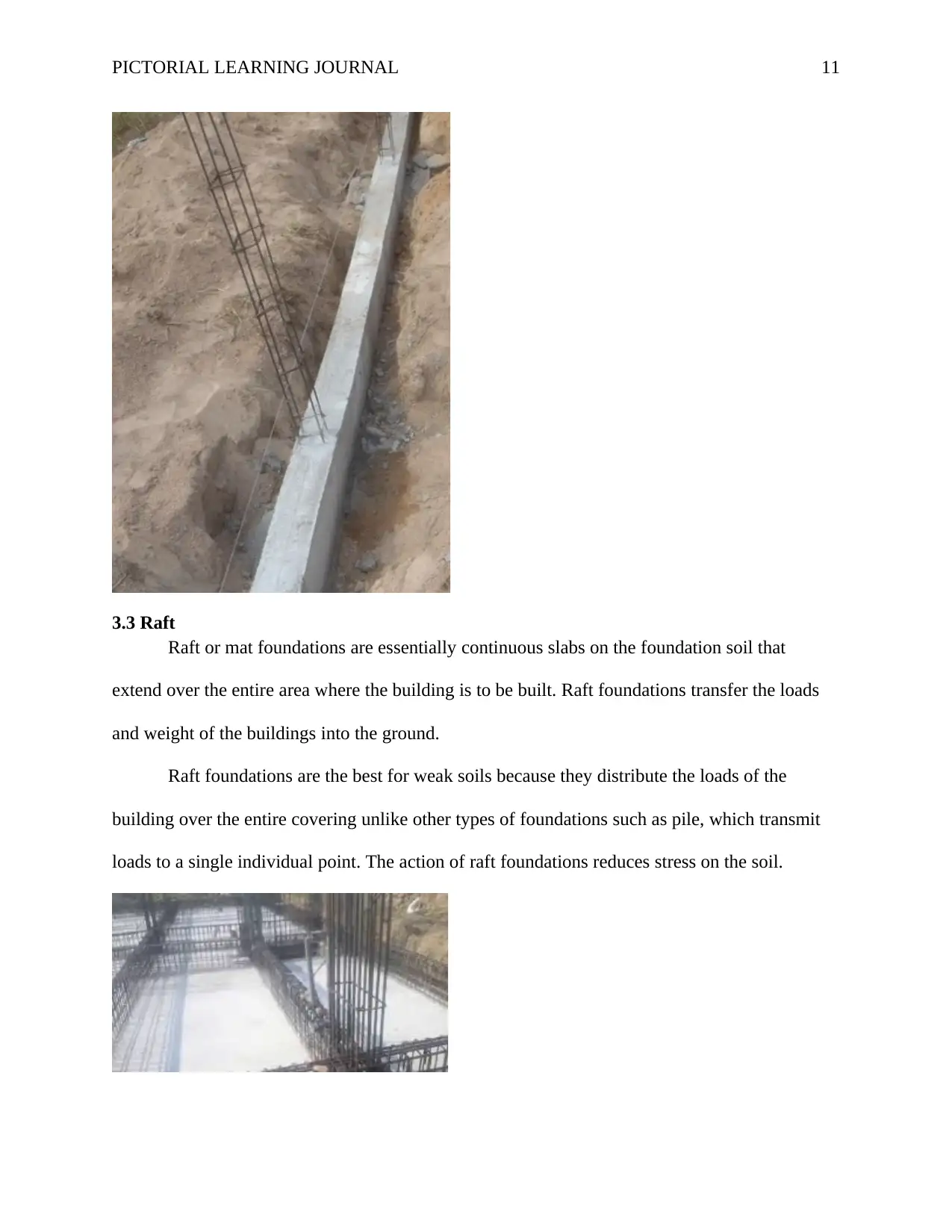
PICTORIAL LEARNING JOURNAL 11
3.3 Raft
Raft or mat foundations are essentially continuous slabs on the foundation soil that
extend over the entire area where the building is to be built. Raft foundations transfer the loads
and weight of the buildings into the ground.
Raft foundations are the best for weak soils because they distribute the loads of the
building over the entire covering unlike other types of foundations such as pile, which transmit
loads to a single individual point. The action of raft foundations reduces stress on the soil.
3.3 Raft
Raft or mat foundations are essentially continuous slabs on the foundation soil that
extend over the entire area where the building is to be built. Raft foundations transfer the loads
and weight of the buildings into the ground.
Raft foundations are the best for weak soils because they distribute the loads of the
building over the entire covering unlike other types of foundations such as pile, which transmit
loads to a single individual point. The action of raft foundations reduces stress on the soil.
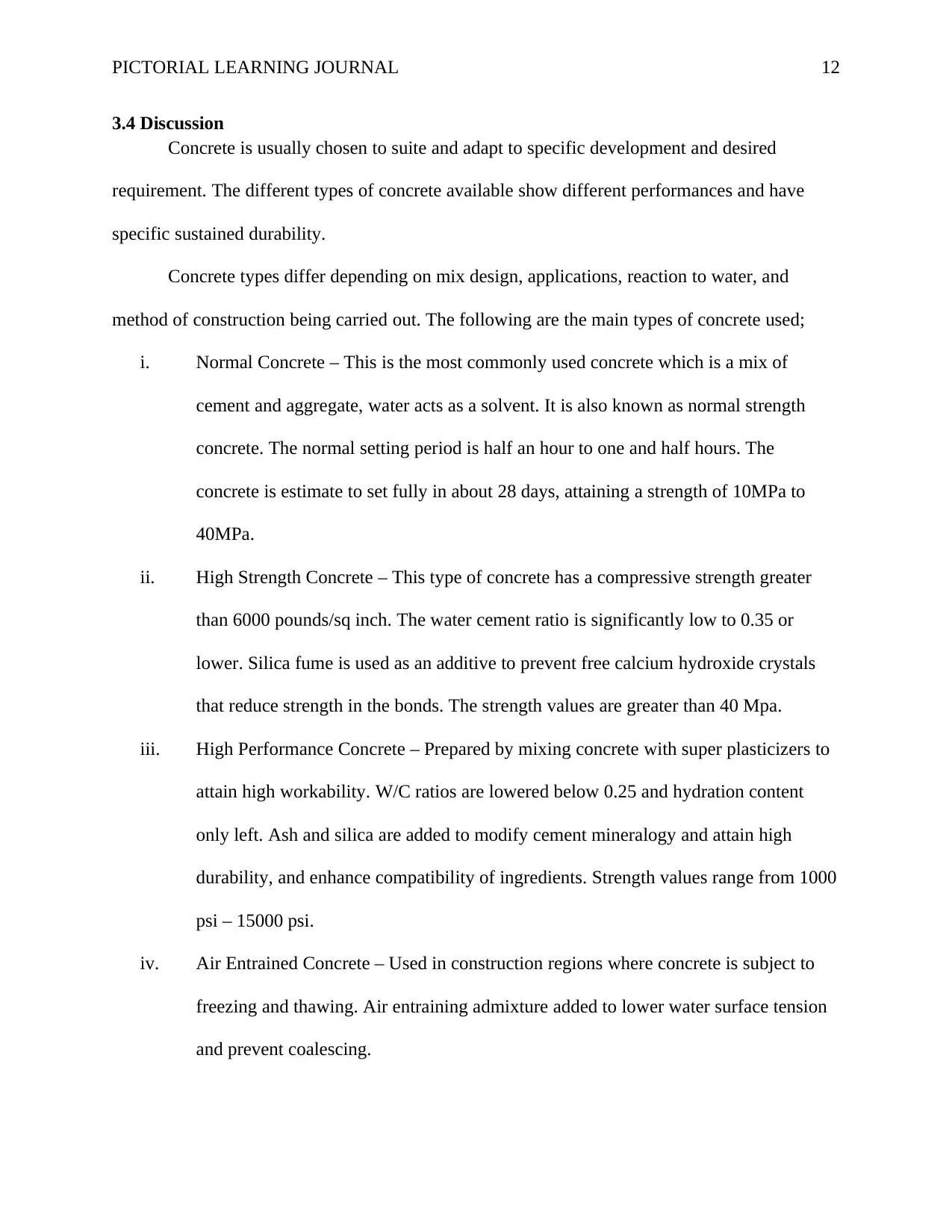
PICTORIAL LEARNING JOURNAL 12
3.4 Discussion
Concrete is usually chosen to suite and adapt to specific development and desired
requirement. The different types of concrete available show different performances and have
specific sustained durability.
Concrete types differ depending on mix design, applications, reaction to water, and
method of construction being carried out. The following are the main types of concrete used;
i. Normal Concrete – This is the most commonly used concrete which is a mix of
cement and aggregate, water acts as a solvent. It is also known as normal strength
concrete. The normal setting period is half an hour to one and half hours. The
concrete is estimate to set fully in about 28 days, attaining a strength of 10MPa to
40MPa.
ii. High Strength Concrete – This type of concrete has a compressive strength greater
than 6000 pounds/sq inch. The water cement ratio is significantly low to 0.35 or
lower. Silica fume is used as an additive to prevent free calcium hydroxide crystals
that reduce strength in the bonds. The strength values are greater than 40 Mpa.
iii. High Performance Concrete – Prepared by mixing concrete with super plasticizers to
attain high workability. W/C ratios are lowered below 0.25 and hydration content
only left. Ash and silica are added to modify cement mineralogy and attain high
durability, and enhance compatibility of ingredients. Strength values range from 1000
psi – 15000 psi.
iv. Air Entrained Concrete – Used in construction regions where concrete is subject to
freezing and thawing. Air entraining admixture added to lower water surface tension
and prevent coalescing.
3.4 Discussion
Concrete is usually chosen to suite and adapt to specific development and desired
requirement. The different types of concrete available show different performances and have
specific sustained durability.
Concrete types differ depending on mix design, applications, reaction to water, and
method of construction being carried out. The following are the main types of concrete used;
i. Normal Concrete – This is the most commonly used concrete which is a mix of
cement and aggregate, water acts as a solvent. It is also known as normal strength
concrete. The normal setting period is half an hour to one and half hours. The
concrete is estimate to set fully in about 28 days, attaining a strength of 10MPa to
40MPa.
ii. High Strength Concrete – This type of concrete has a compressive strength greater
than 6000 pounds/sq inch. The water cement ratio is significantly low to 0.35 or
lower. Silica fume is used as an additive to prevent free calcium hydroxide crystals
that reduce strength in the bonds. The strength values are greater than 40 Mpa.
iii. High Performance Concrete – Prepared by mixing concrete with super plasticizers to
attain high workability. W/C ratios are lowered below 0.25 and hydration content
only left. Ash and silica are added to modify cement mineralogy and attain high
durability, and enhance compatibility of ingredients. Strength values range from 1000
psi – 15000 psi.
iv. Air Entrained Concrete – Used in construction regions where concrete is subject to
freezing and thawing. Air entraining admixture added to lower water surface tension
and prevent coalescing.
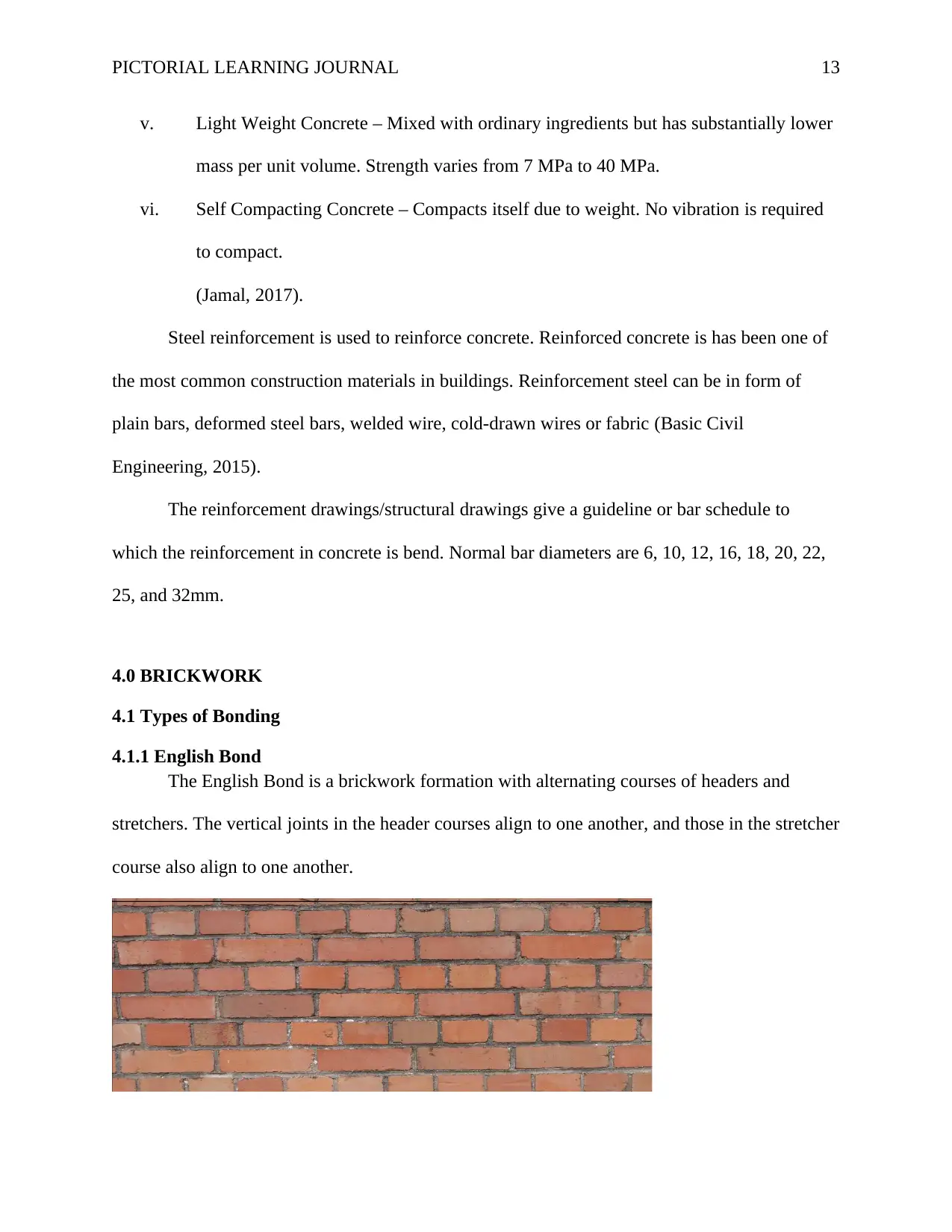
PICTORIAL LEARNING JOURNAL 13
v. Light Weight Concrete – Mixed with ordinary ingredients but has substantially lower
mass per unit volume. Strength varies from 7 MPa to 40 MPa.
vi. Self Compacting Concrete – Compacts itself due to weight. No vibration is required
to compact.
(Jamal, 2017).
Steel reinforcement is used to reinforce concrete. Reinforced concrete is has been one of
the most common construction materials in buildings. Reinforcement steel can be in form of
plain bars, deformed steel bars, welded wire, cold-drawn wires or fabric (Basic Civil
Engineering, 2015).
The reinforcement drawings/structural drawings give a guideline or bar schedule to
which the reinforcement in concrete is bend. Normal bar diameters are 6, 10, 12, 16, 18, 20, 22,
25, and 32mm.
4.0 BRICKWORK
4.1 Types of Bonding
4.1.1 English Bond
The English Bond is a brickwork formation with alternating courses of headers and
stretchers. The vertical joints in the header courses align to one another, and those in the stretcher
course also align to one another.
v. Light Weight Concrete – Mixed with ordinary ingredients but has substantially lower
mass per unit volume. Strength varies from 7 MPa to 40 MPa.
vi. Self Compacting Concrete – Compacts itself due to weight. No vibration is required
to compact.
(Jamal, 2017).
Steel reinforcement is used to reinforce concrete. Reinforced concrete is has been one of
the most common construction materials in buildings. Reinforcement steel can be in form of
plain bars, deformed steel bars, welded wire, cold-drawn wires or fabric (Basic Civil
Engineering, 2015).
The reinforcement drawings/structural drawings give a guideline or bar schedule to
which the reinforcement in concrete is bend. Normal bar diameters are 6, 10, 12, 16, 18, 20, 22,
25, and 32mm.
4.0 BRICKWORK
4.1 Types of Bonding
4.1.1 English Bond
The English Bond is a brickwork formation with alternating courses of headers and
stretchers. The vertical joints in the header courses align to one another, and those in the stretcher
course also align to one another.
Paraphrase This Document
Need a fresh take? Get an instant paraphrase of this document with our AI Paraphraser
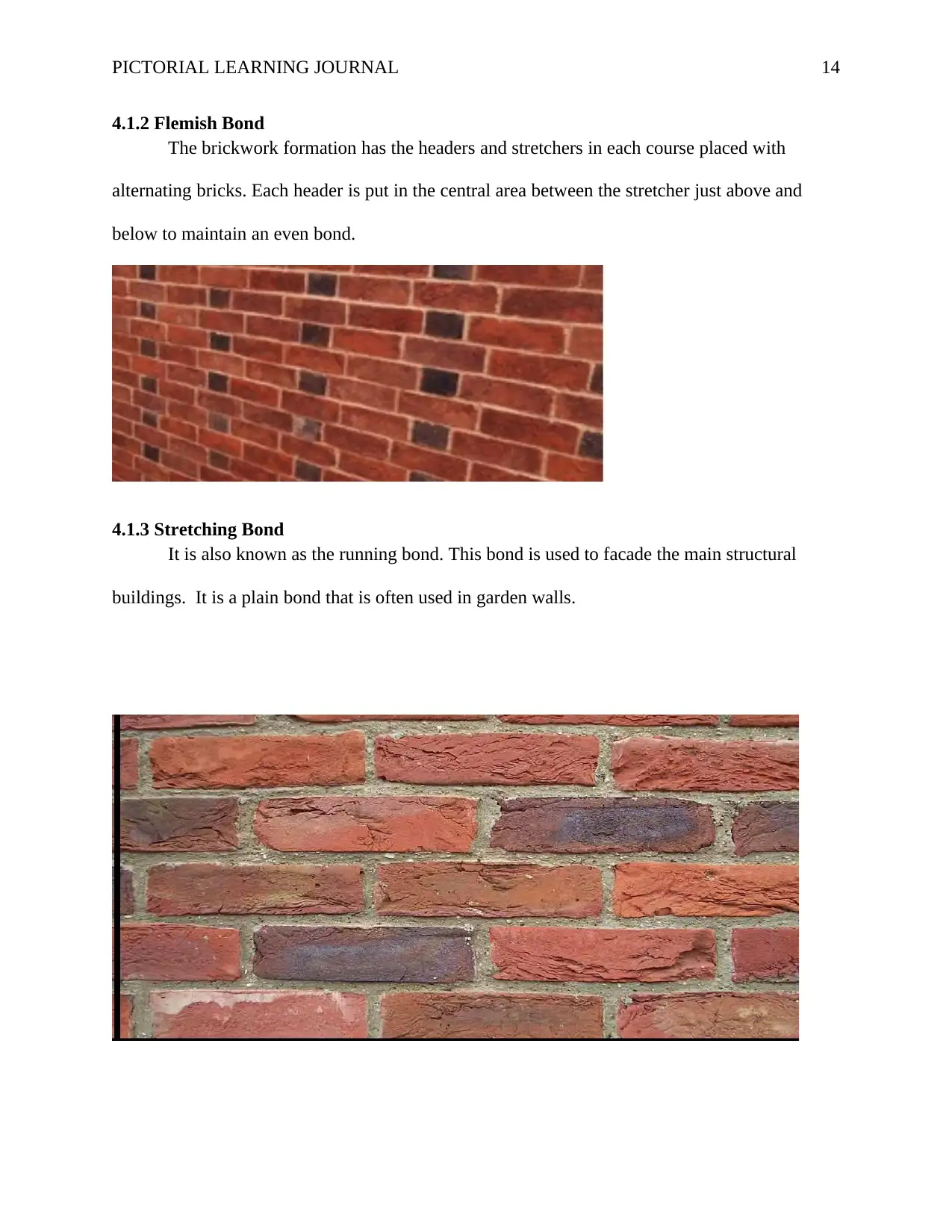
PICTORIAL LEARNING JOURNAL 14
4.1.2 Flemish Bond
The brickwork formation has the headers and stretchers in each course placed with
alternating bricks. Each header is put in the central area between the stretcher just above and
below to maintain an even bond.
4.1.3 Stretching Bond
It is also known as the running bond. This bond is used to facade the main structural
buildings. It is a plain bond that is often used in garden walls.
4.1.2 Flemish Bond
The brickwork formation has the headers and stretchers in each course placed with
alternating bricks. Each header is put in the central area between the stretcher just above and
below to maintain an even bond.
4.1.3 Stretching Bond
It is also known as the running bond. This bond is used to facade the main structural
buildings. It is a plain bond that is often used in garden walls.
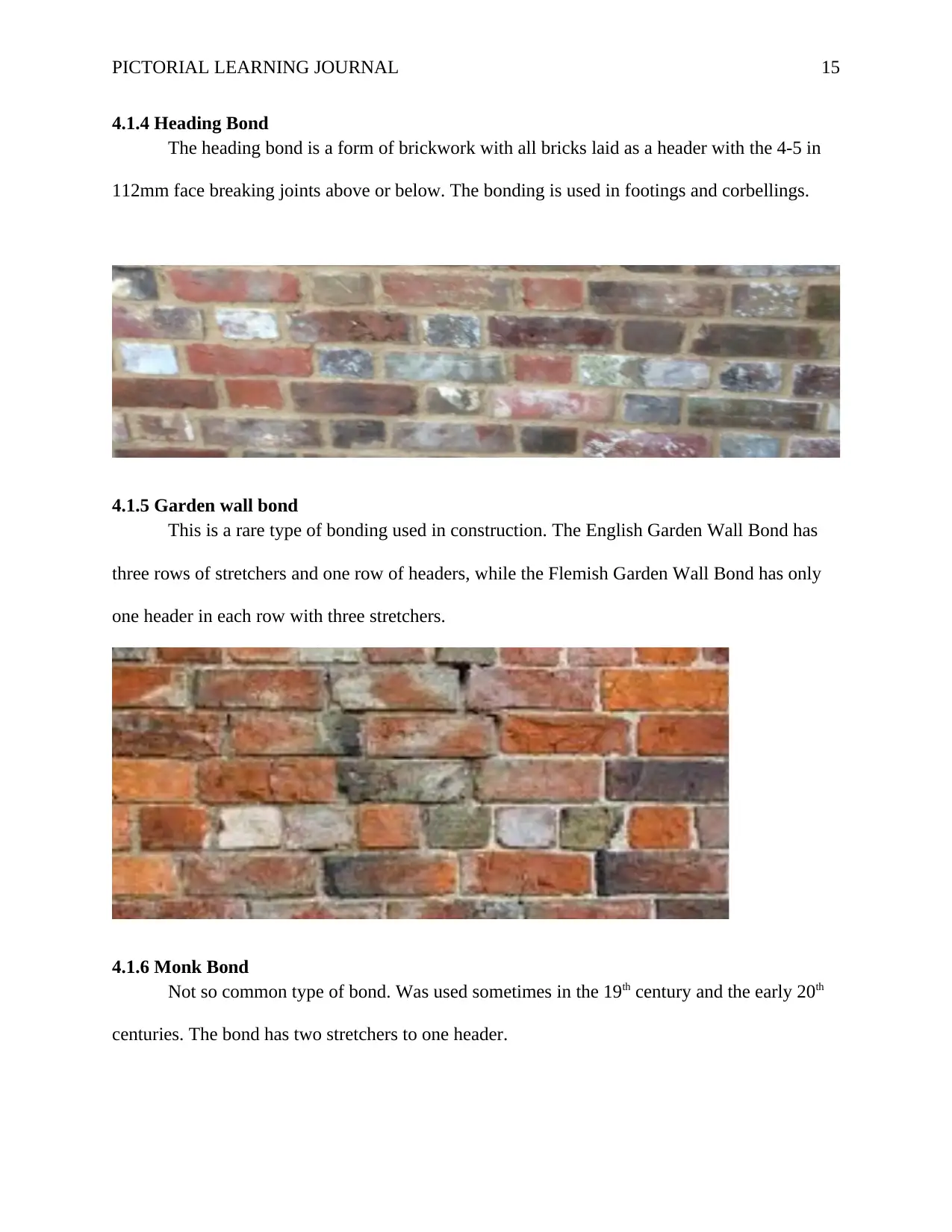
PICTORIAL LEARNING JOURNAL 15
4.1.4 Heading Bond
The heading bond is a form of brickwork with all bricks laid as a header with the 4-5 in
112mm face breaking joints above or below. The bonding is used in footings and corbellings.
4.1.5 Garden wall bond
This is a rare type of bonding used in construction. The English Garden Wall Bond has
three rows of stretchers and one row of headers, while the Flemish Garden Wall Bond has only
one header in each row with three stretchers.
4.1.6 Monk Bond
Not so common type of bond. Was used sometimes in the 19th century and the early 20th
centuries. The bond has two stretchers to one header.
4.1.4 Heading Bond
The heading bond is a form of brickwork with all bricks laid as a header with the 4-5 in
112mm face breaking joints above or below. The bonding is used in footings and corbellings.
4.1.5 Garden wall bond
This is a rare type of bonding used in construction. The English Garden Wall Bond has
three rows of stretchers and one row of headers, while the Flemish Garden Wall Bond has only
one header in each row with three stretchers.
4.1.6 Monk Bond
Not so common type of bond. Was used sometimes in the 19th century and the early 20th
centuries. The bond has two stretchers to one header.
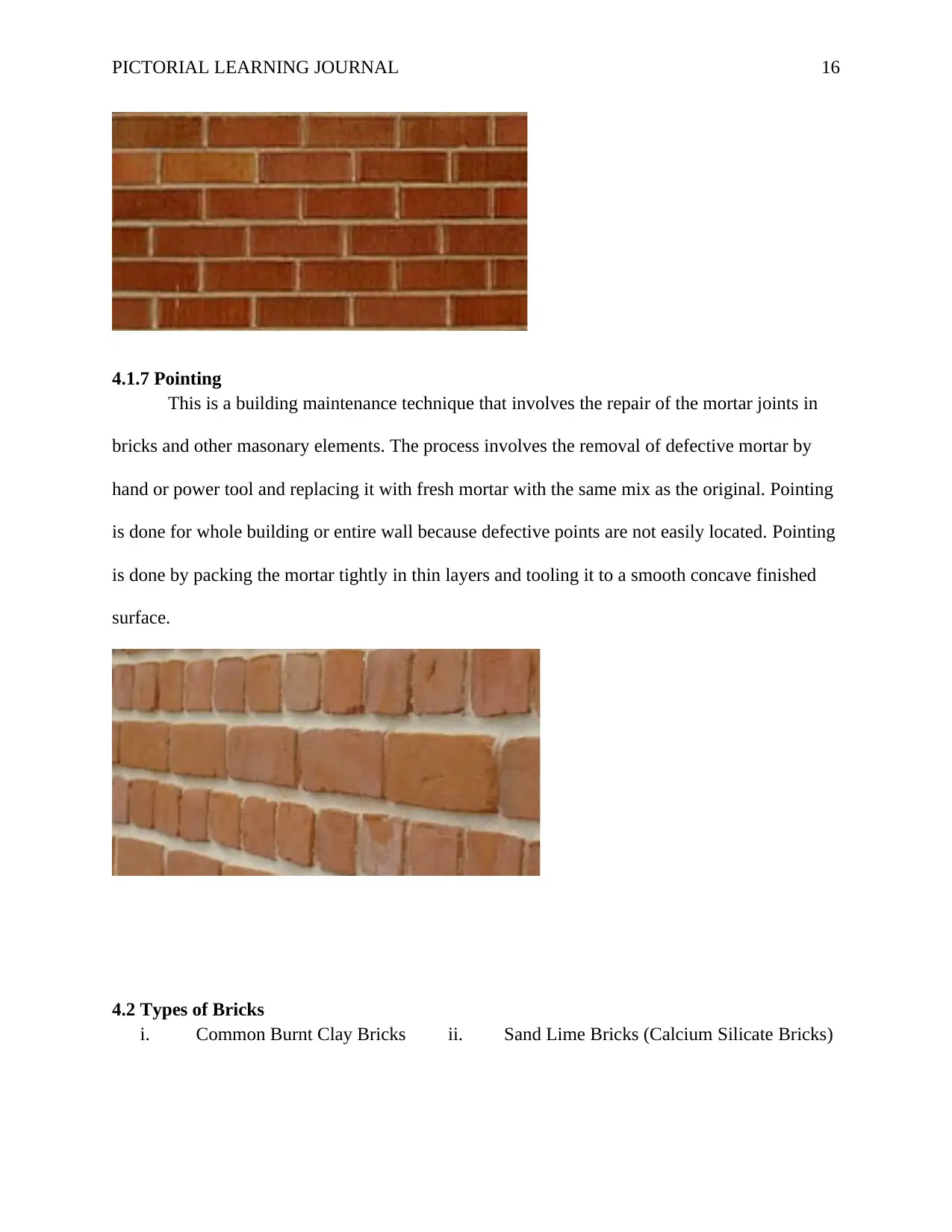
PICTORIAL LEARNING JOURNAL 16
4.1.7 Pointing
This is a building maintenance technique that involves the repair of the mortar joints in
bricks and other masonary elements. The process involves the removal of defective mortar by
hand or power tool and replacing it with fresh mortar with the same mix as the original. Pointing
is done for whole building or entire wall because defective points are not easily located. Pointing
is done by packing the mortar tightly in thin layers and tooling it to a smooth concave finished
surface.
4.2 Types of Bricks
i. Common Burnt Clay Bricks ii. Sand Lime Bricks (Calcium Silicate Bricks)
4.1.7 Pointing
This is a building maintenance technique that involves the repair of the mortar joints in
bricks and other masonary elements. The process involves the removal of defective mortar by
hand or power tool and replacing it with fresh mortar with the same mix as the original. Pointing
is done for whole building or entire wall because defective points are not easily located. Pointing
is done by packing the mortar tightly in thin layers and tooling it to a smooth concave finished
surface.
4.2 Types of Bricks
i. Common Burnt Clay Bricks ii. Sand Lime Bricks (Calcium Silicate Bricks)
Secure Best Marks with AI Grader
Need help grading? Try our AI Grader for instant feedback on your assignments.
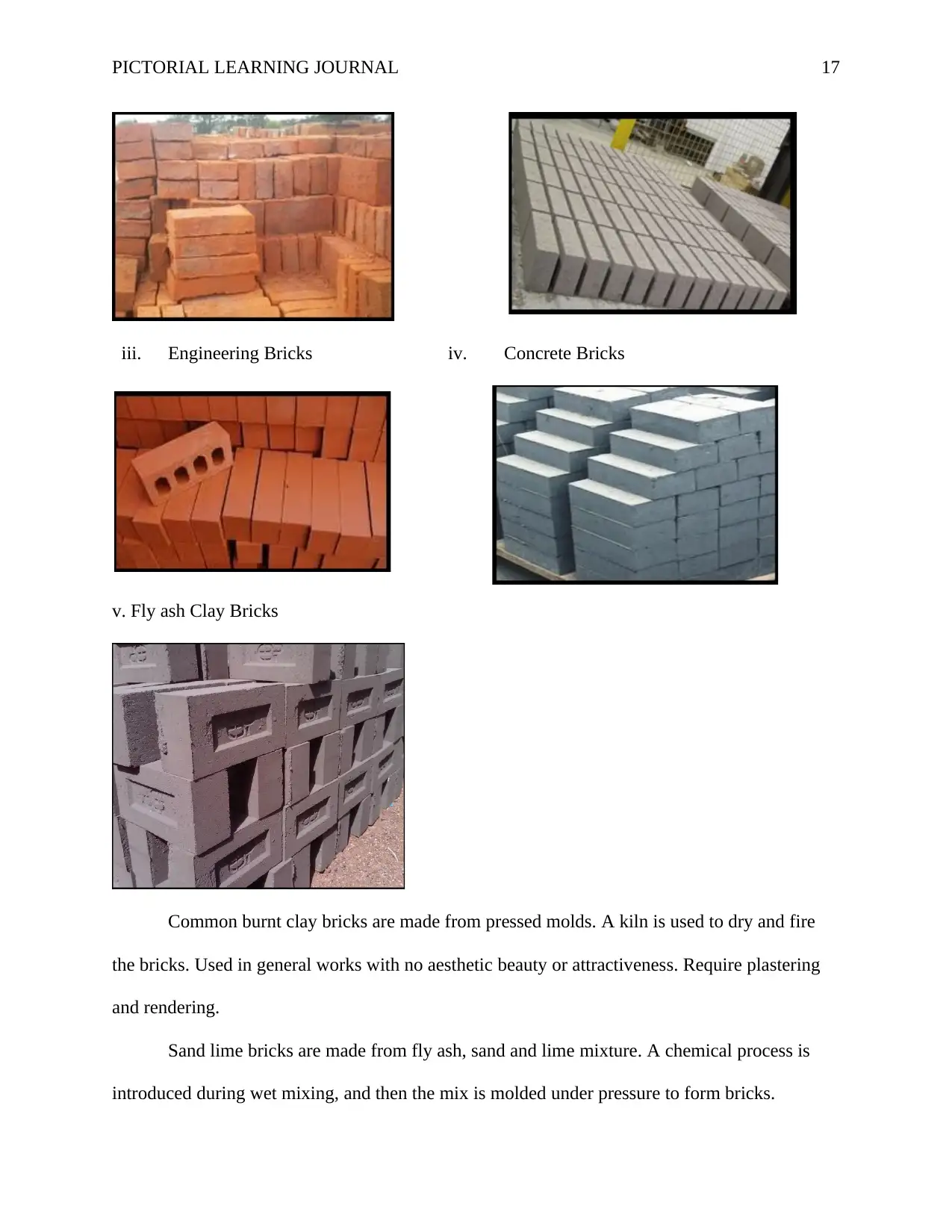
PICTORIAL LEARNING JOURNAL 17
iii. Engineering Bricks iv. Concrete Bricks
v. Fly ash Clay Bricks
Common burnt clay bricks are made from pressed molds. A kiln is used to dry and fire
the bricks. Used in general works with no aesthetic beauty or attractiveness. Require plastering
and rendering.
Sand lime bricks are made from fly ash, sand and lime mixture. A chemical process is
introduced during wet mixing, and then the mix is molded under pressure to form bricks.
iii. Engineering Bricks iv. Concrete Bricks
v. Fly ash Clay Bricks
Common burnt clay bricks are made from pressed molds. A kiln is used to dry and fire
the bricks. Used in general works with no aesthetic beauty or attractiveness. Require plastering
and rendering.
Sand lime bricks are made from fly ash, sand and lime mixture. A chemical process is
introduced during wet mixing, and then the mix is molded under pressure to form bricks.
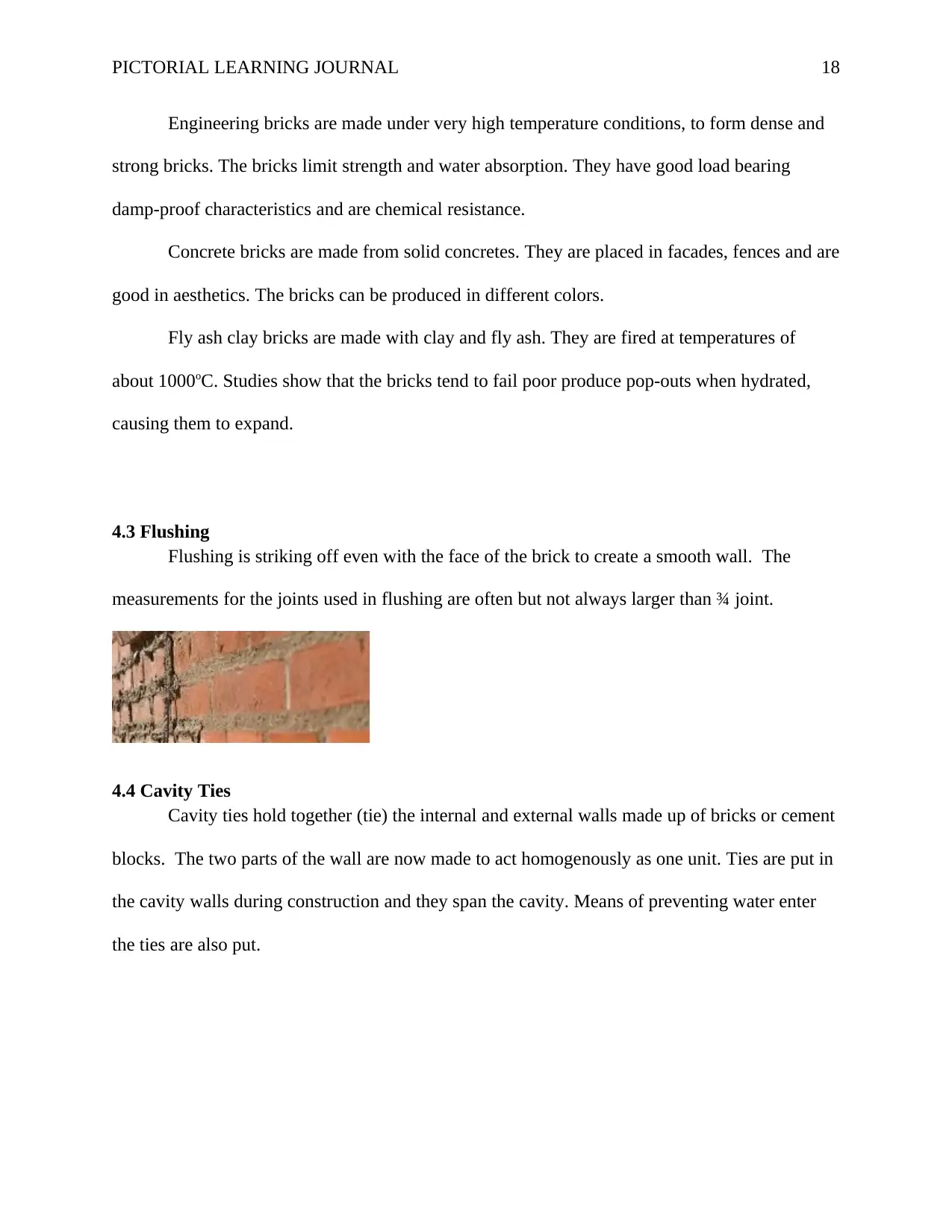
PICTORIAL LEARNING JOURNAL 18
Engineering bricks are made under very high temperature conditions, to form dense and
strong bricks. The bricks limit strength and water absorption. They have good load bearing
damp-proof characteristics and are chemical resistance.
Concrete bricks are made from solid concretes. They are placed in facades, fences and are
good in aesthetics. The bricks can be produced in different colors.
Fly ash clay bricks are made with clay and fly ash. They are fired at temperatures of
about 1000oC. Studies show that the bricks tend to fail poor produce pop-outs when hydrated,
causing them to expand.
4.3 Flushing
Flushing is striking off even with the face of the brick to create a smooth wall. The
measurements for the joints used in flushing are often but not always larger than ¾ joint.
4.4 Cavity Ties
Cavity ties hold together (tie) the internal and external walls made up of bricks or cement
blocks. The two parts of the wall are now made to act homogenously as one unit. Ties are put in
the cavity walls during construction and they span the cavity. Means of preventing water enter
the ties are also put.
Engineering bricks are made under very high temperature conditions, to form dense and
strong bricks. The bricks limit strength and water absorption. They have good load bearing
damp-proof characteristics and are chemical resistance.
Concrete bricks are made from solid concretes. They are placed in facades, fences and are
good in aesthetics. The bricks can be produced in different colors.
Fly ash clay bricks are made with clay and fly ash. They are fired at temperatures of
about 1000oC. Studies show that the bricks tend to fail poor produce pop-outs when hydrated,
causing them to expand.
4.3 Flushing
Flushing is striking off even with the face of the brick to create a smooth wall. The
measurements for the joints used in flushing are often but not always larger than ¾ joint.
4.4 Cavity Ties
Cavity ties hold together (tie) the internal and external walls made up of bricks or cement
blocks. The two parts of the wall are now made to act homogenously as one unit. Ties are put in
the cavity walls during construction and they span the cavity. Means of preventing water enter
the ties are also put.
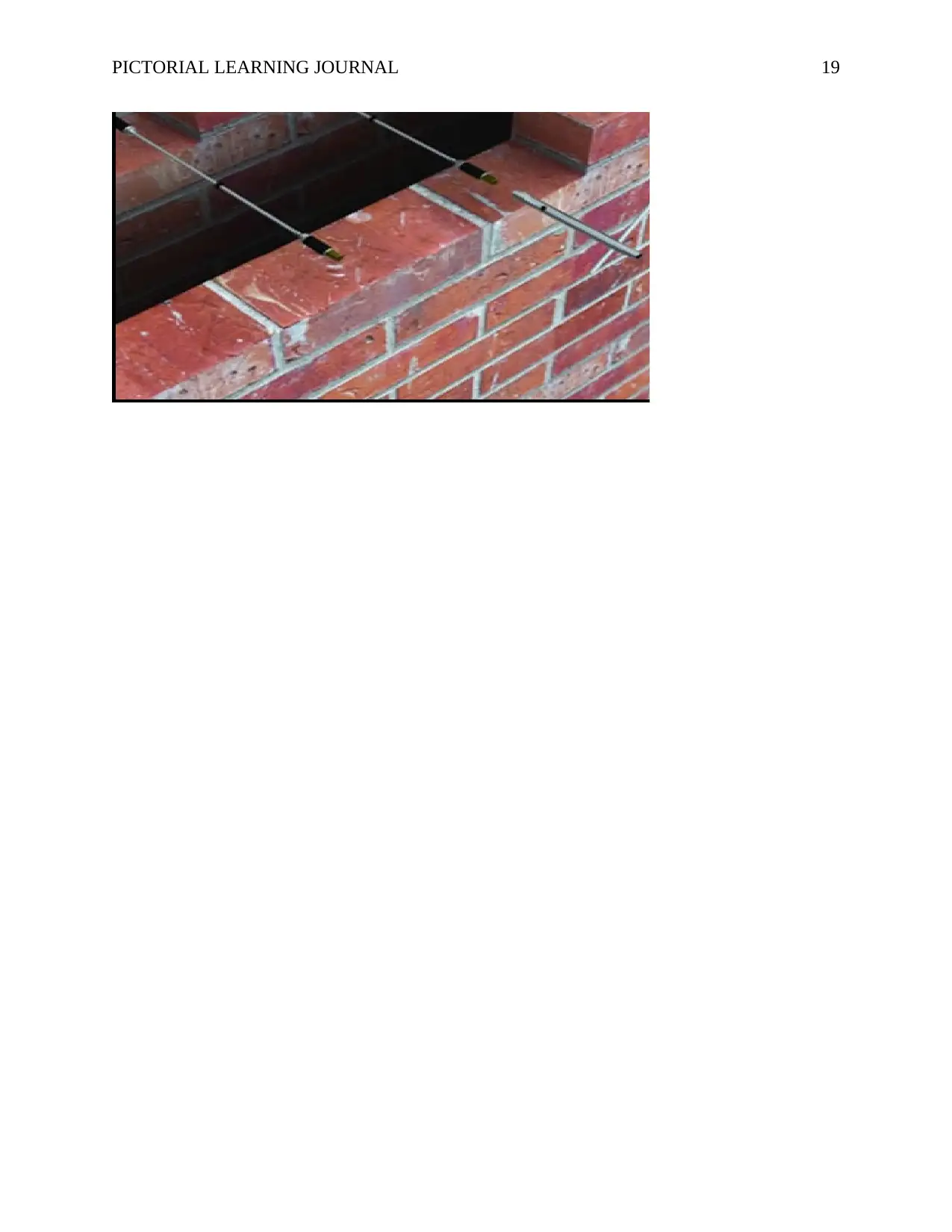
PICTORIAL LEARNING JOURNAL 19
Paraphrase This Document
Need a fresh take? Get an instant paraphrase of this document with our AI Paraphraser
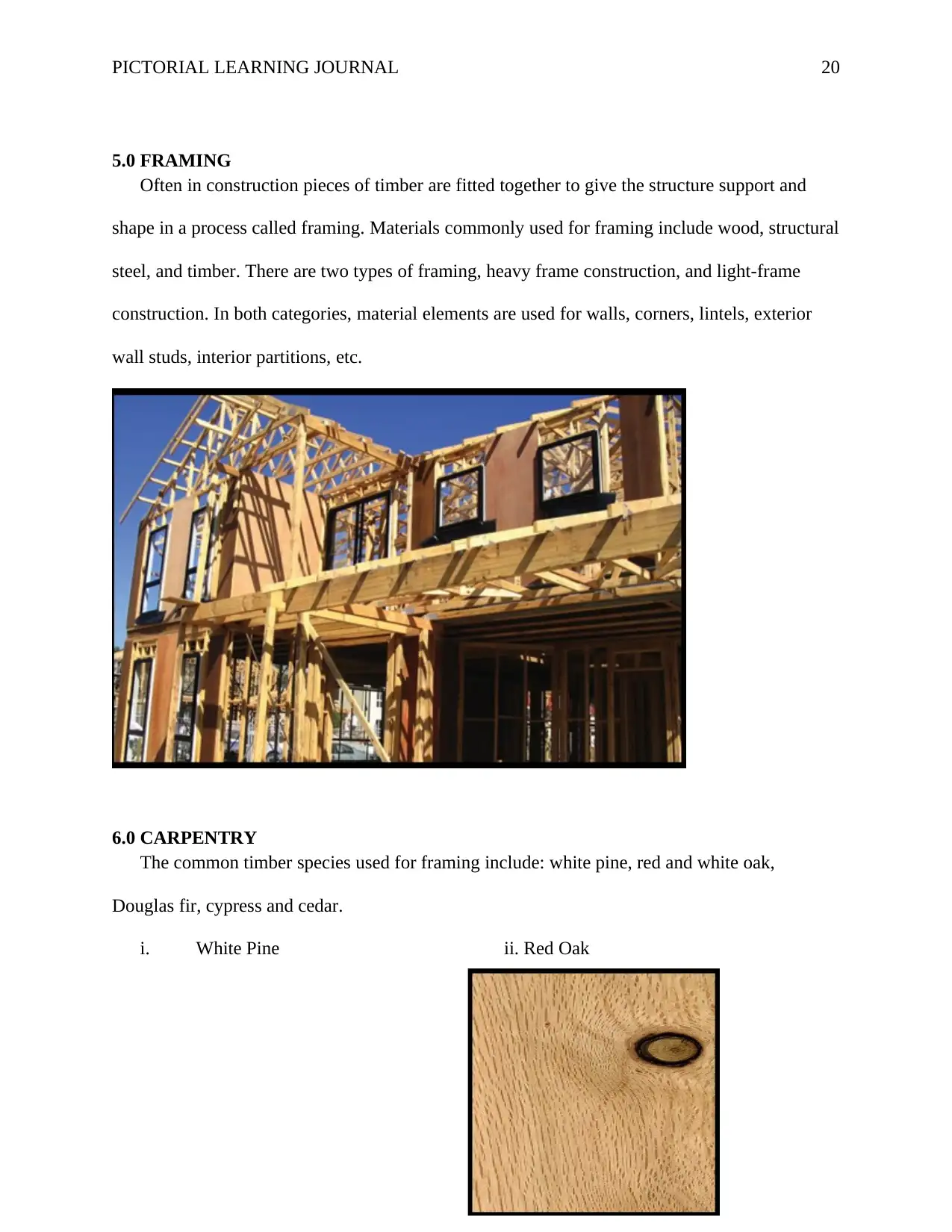
PICTORIAL LEARNING JOURNAL 20
5.0 FRAMING
Often in construction pieces of timber are fitted together to give the structure support and
shape in a process called framing. Materials commonly used for framing include wood, structural
steel, and timber. There are two types of framing, heavy frame construction, and light-frame
construction. In both categories, material elements are used for walls, corners, lintels, exterior
wall studs, interior partitions, etc.
6.0 CARPENTRY
The common timber species used for framing include: white pine, red and white oak,
Douglas fir, cypress and cedar.
i. White Pine ii. Red Oak
5.0 FRAMING
Often in construction pieces of timber are fitted together to give the structure support and
shape in a process called framing. Materials commonly used for framing include wood, structural
steel, and timber. There are two types of framing, heavy frame construction, and light-frame
construction. In both categories, material elements are used for walls, corners, lintels, exterior
wall studs, interior partitions, etc.
6.0 CARPENTRY
The common timber species used for framing include: white pine, red and white oak,
Douglas fir, cypress and cedar.
i. White Pine ii. Red Oak
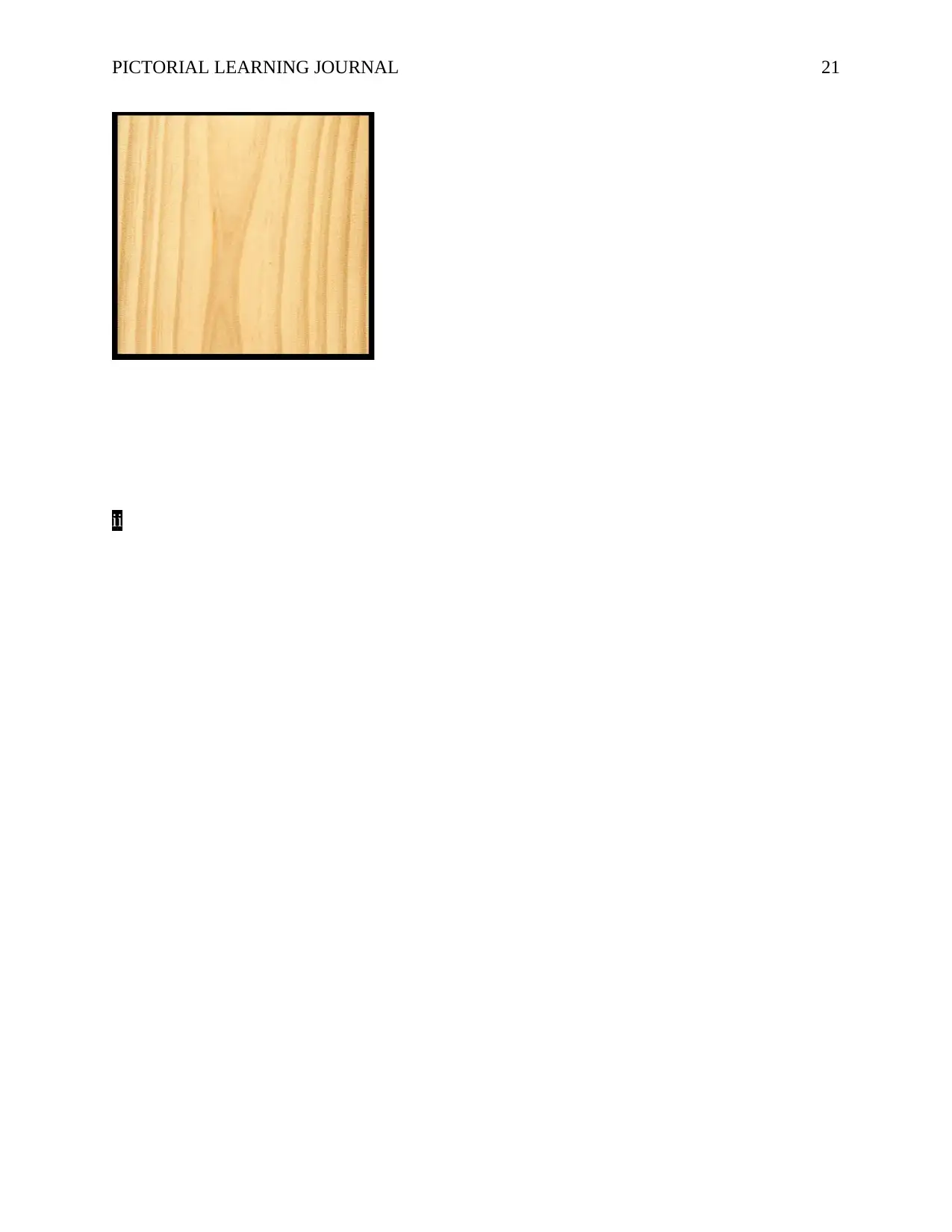
PICTORIAL LEARNING JOURNAL 21
ii
ii
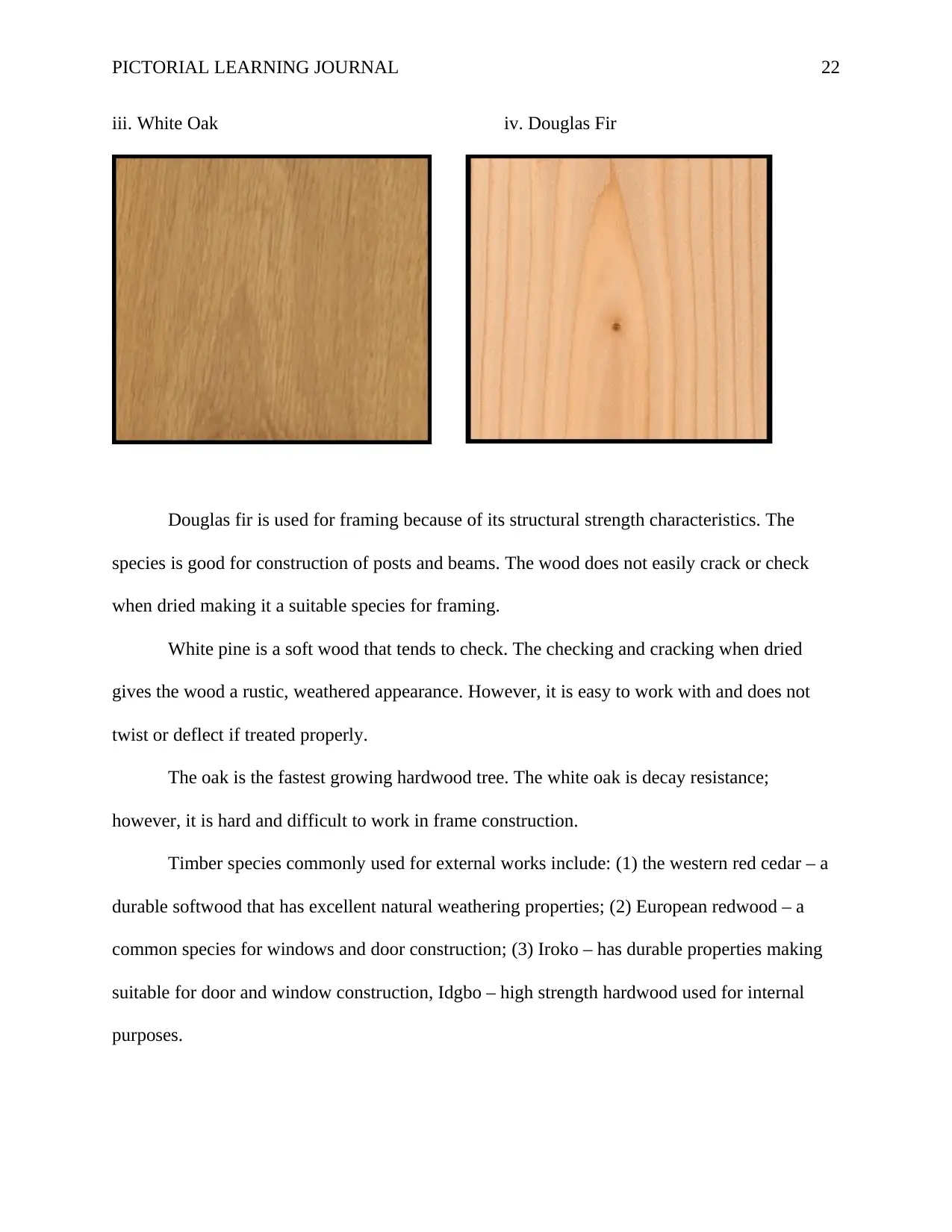
PICTORIAL LEARNING JOURNAL 22
iii. White Oak iv. Douglas Fir
Douglas fir is used for framing because of its structural strength characteristics. The
species is good for construction of posts and beams. The wood does not easily crack or check
when dried making it a suitable species for framing.
White pine is a soft wood that tends to check. The checking and cracking when dried
gives the wood a rustic, weathered appearance. However, it is easy to work with and does not
twist or deflect if treated properly.
The oak is the fastest growing hardwood tree. The white oak is decay resistance;
however, it is hard and difficult to work in frame construction.
Timber species commonly used for external works include: (1) the western red cedar – a
durable softwood that has excellent natural weathering properties; (2) European redwood – a
common species for windows and door construction; (3) Iroko – has durable properties making
suitable for door and window construction, Idgbo – high strength hardwood used for internal
purposes.
iii. White Oak iv. Douglas Fir
Douglas fir is used for framing because of its structural strength characteristics. The
species is good for construction of posts and beams. The wood does not easily crack or check
when dried making it a suitable species for framing.
White pine is a soft wood that tends to check. The checking and cracking when dried
gives the wood a rustic, weathered appearance. However, it is easy to work with and does not
twist or deflect if treated properly.
The oak is the fastest growing hardwood tree. The white oak is decay resistance;
however, it is hard and difficult to work in frame construction.
Timber species commonly used for external works include: (1) the western red cedar – a
durable softwood that has excellent natural weathering properties; (2) European redwood – a
common species for windows and door construction; (3) Iroko – has durable properties making
suitable for door and window construction, Idgbo – high strength hardwood used for internal
purposes.
Secure Best Marks with AI Grader
Need help grading? Try our AI Grader for instant feedback on your assignments.
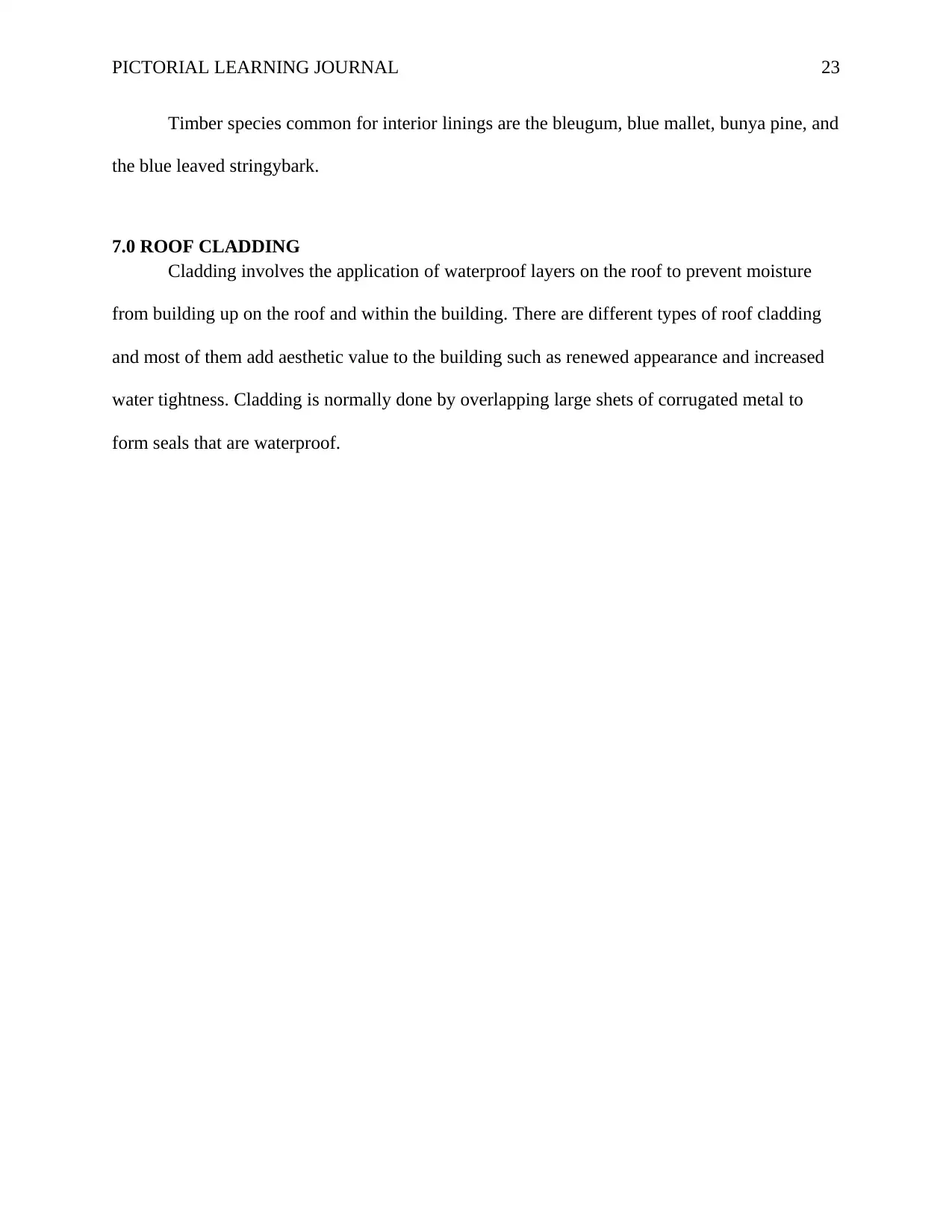
PICTORIAL LEARNING JOURNAL 23
Timber species common for interior linings are the bleugum, blue mallet, bunya pine, and
the blue leaved stringybark.
7.0 ROOF CLADDING
Cladding involves the application of waterproof layers on the roof to prevent moisture
from building up on the roof and within the building. There are different types of roof cladding
and most of them add aesthetic value to the building such as renewed appearance and increased
water tightness. Cladding is normally done by overlapping large shets of corrugated metal to
form seals that are waterproof.
Timber species common for interior linings are the bleugum, blue mallet, bunya pine, and
the blue leaved stringybark.
7.0 ROOF CLADDING
Cladding involves the application of waterproof layers on the roof to prevent moisture
from building up on the roof and within the building. There are different types of roof cladding
and most of them add aesthetic value to the building such as renewed appearance and increased
water tightness. Cladding is normally done by overlapping large shets of corrugated metal to
form seals that are waterproof.
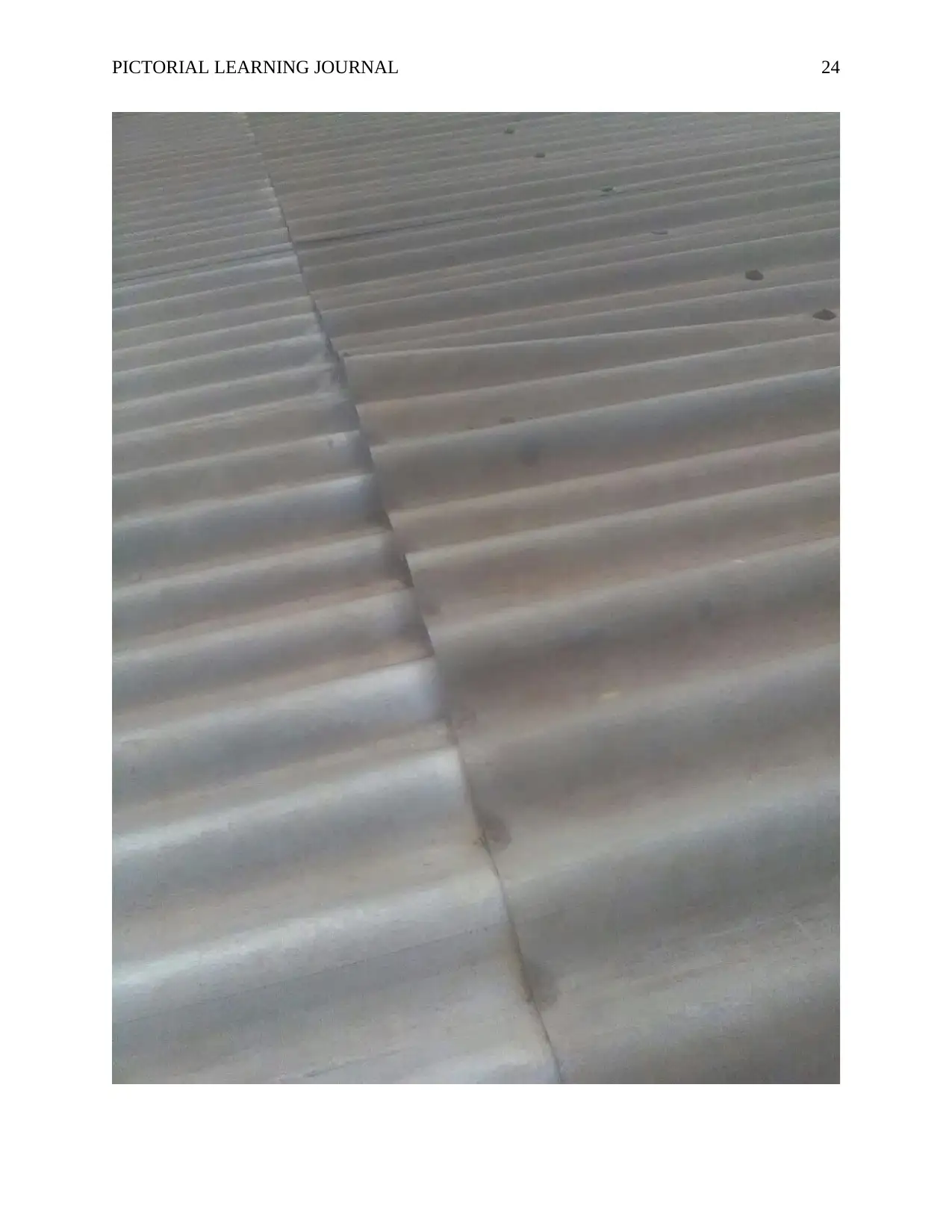
PICTORIAL LEARNING JOURNAL 24
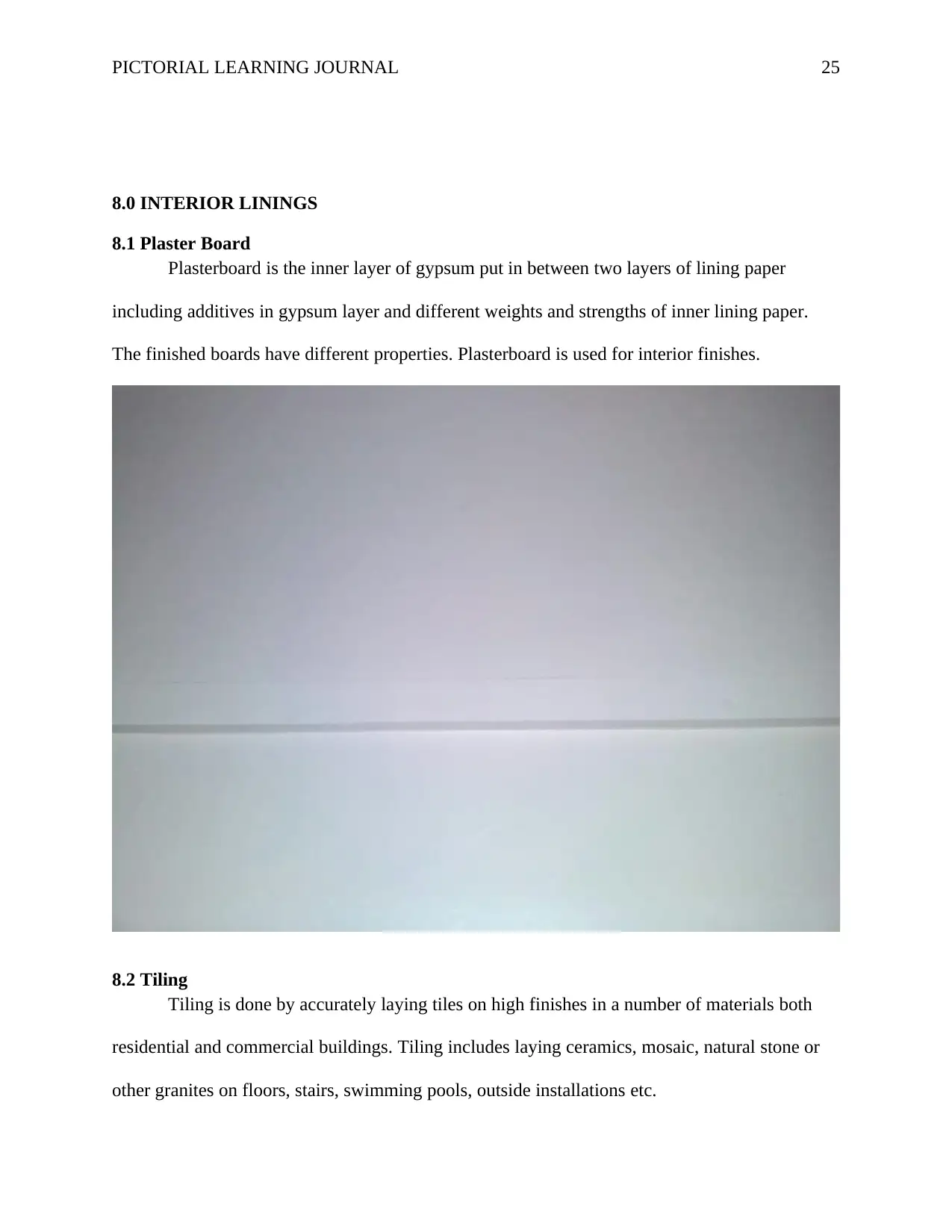
PICTORIAL LEARNING JOURNAL 25
8.0 INTERIOR LININGS
8.1 Plaster Board
Plasterboard is the inner layer of gypsum put in between two layers of lining paper
including additives in gypsum layer and different weights and strengths of inner lining paper.
The finished boards have different properties. Plasterboard is used for interior finishes.
8.2 Tiling
Tiling is done by accurately laying tiles on high finishes in a number of materials both
residential and commercial buildings. Tiling includes laying ceramics, mosaic, natural stone or
other granites on floors, stairs, swimming pools, outside installations etc.
8.0 INTERIOR LININGS
8.1 Plaster Board
Plasterboard is the inner layer of gypsum put in between two layers of lining paper
including additives in gypsum layer and different weights and strengths of inner lining paper.
The finished boards have different properties. Plasterboard is used for interior finishes.
8.2 Tiling
Tiling is done by accurately laying tiles on high finishes in a number of materials both
residential and commercial buildings. Tiling includes laying ceramics, mosaic, natural stone or
other granites on floors, stairs, swimming pools, outside installations etc.
Paraphrase This Document
Need a fresh take? Get an instant paraphrase of this document with our AI Paraphraser
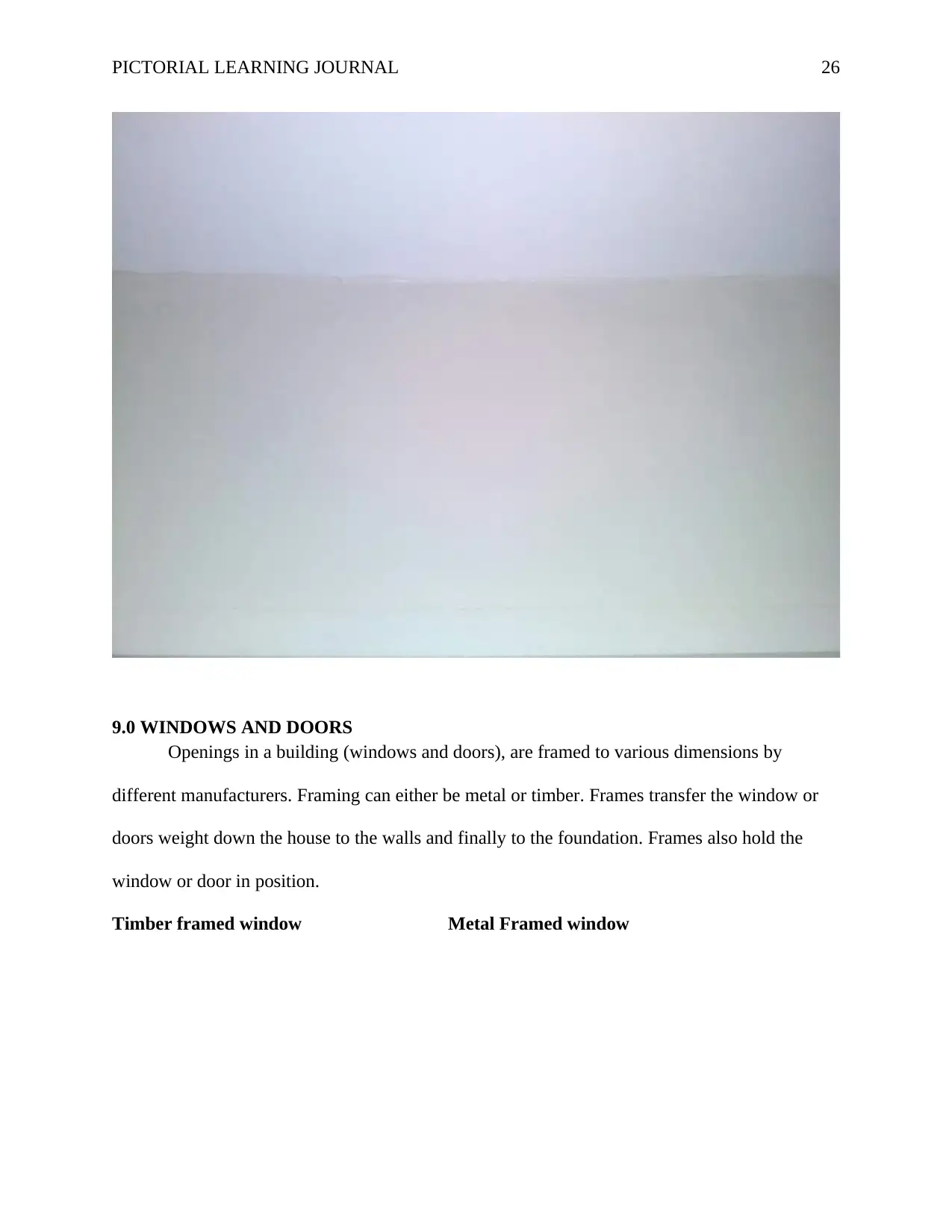
PICTORIAL LEARNING JOURNAL 26
9.0 WINDOWS AND DOORS
Openings in a building (windows and doors), are framed to various dimensions by
different manufacturers. Framing can either be metal or timber. Frames transfer the window or
doors weight down the house to the walls and finally to the foundation. Frames also hold the
window or door in position.
Timber framed window Metal Framed window
9.0 WINDOWS AND DOORS
Openings in a building (windows and doors), are framed to various dimensions by
different manufacturers. Framing can either be metal or timber. Frames transfer the window or
doors weight down the house to the walls and finally to the foundation. Frames also hold the
window or door in position.
Timber framed window Metal Framed window
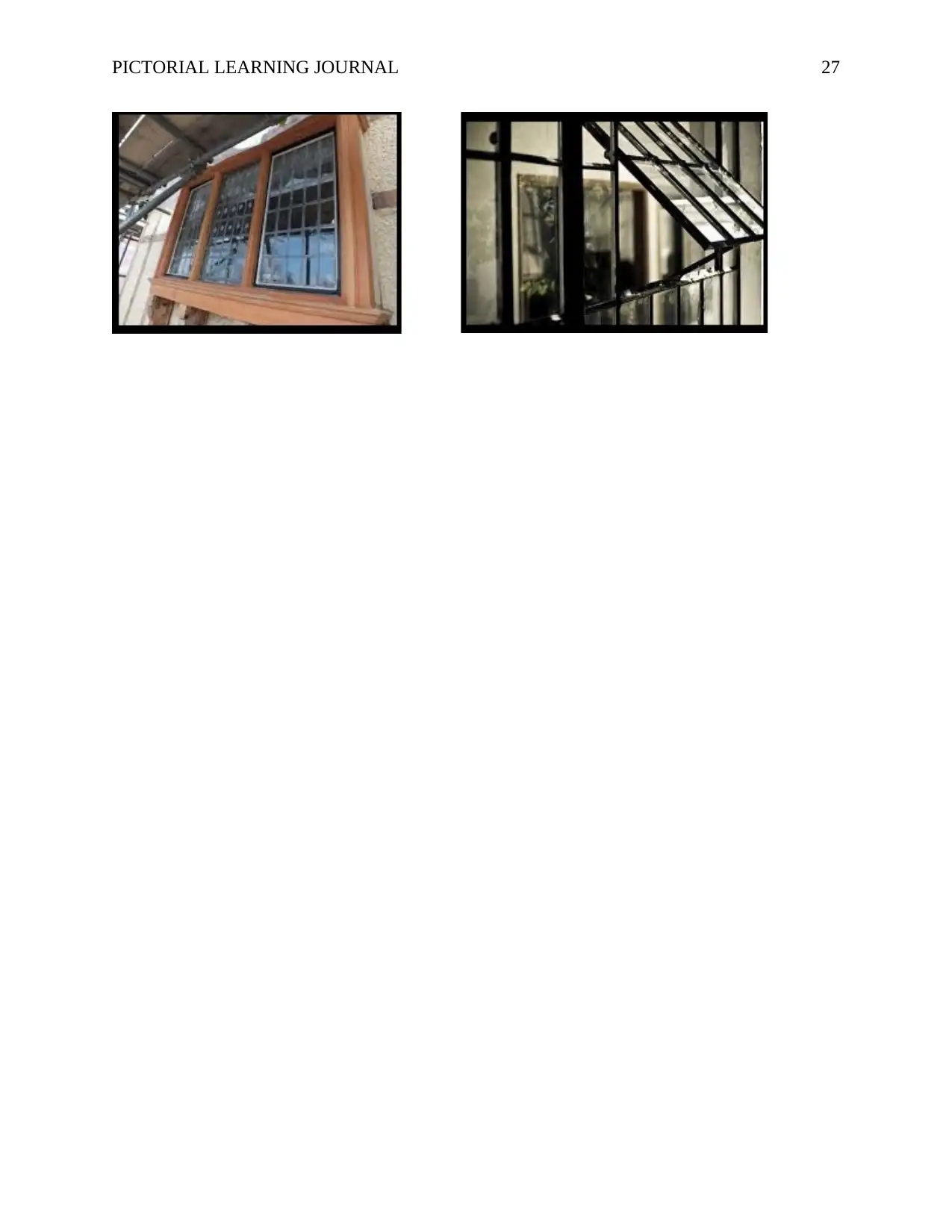
PICTORIAL LEARNING JOURNAL 27

PICTORIAL LEARNING JOURNAL 28
Timber Framed Door Metal Framed Door
10.0 SERVICES
Services provide shelter take care of heat and cold, effects of the sun and rain, and also
provide comfortable and conducive working environment where people can live i.e safety,
efficiency and comfort. Building services include, energy generation, distribution and supply,
escalators and lifts, façade engineering, and fire safety and detection. Others include gas supply,
telecom and lighting.
Timber Framed Door Metal Framed Door
10.0 SERVICES
Services provide shelter take care of heat and cold, effects of the sun and rain, and also
provide comfortable and conducive working environment where people can live i.e safety,
efficiency and comfort. Building services include, energy generation, distribution and supply,
escalators and lifts, façade engineering, and fire safety and detection. Others include gas supply,
telecom and lighting.
Secure Best Marks with AI Grader
Need help grading? Try our AI Grader for instant feedback on your assignments.
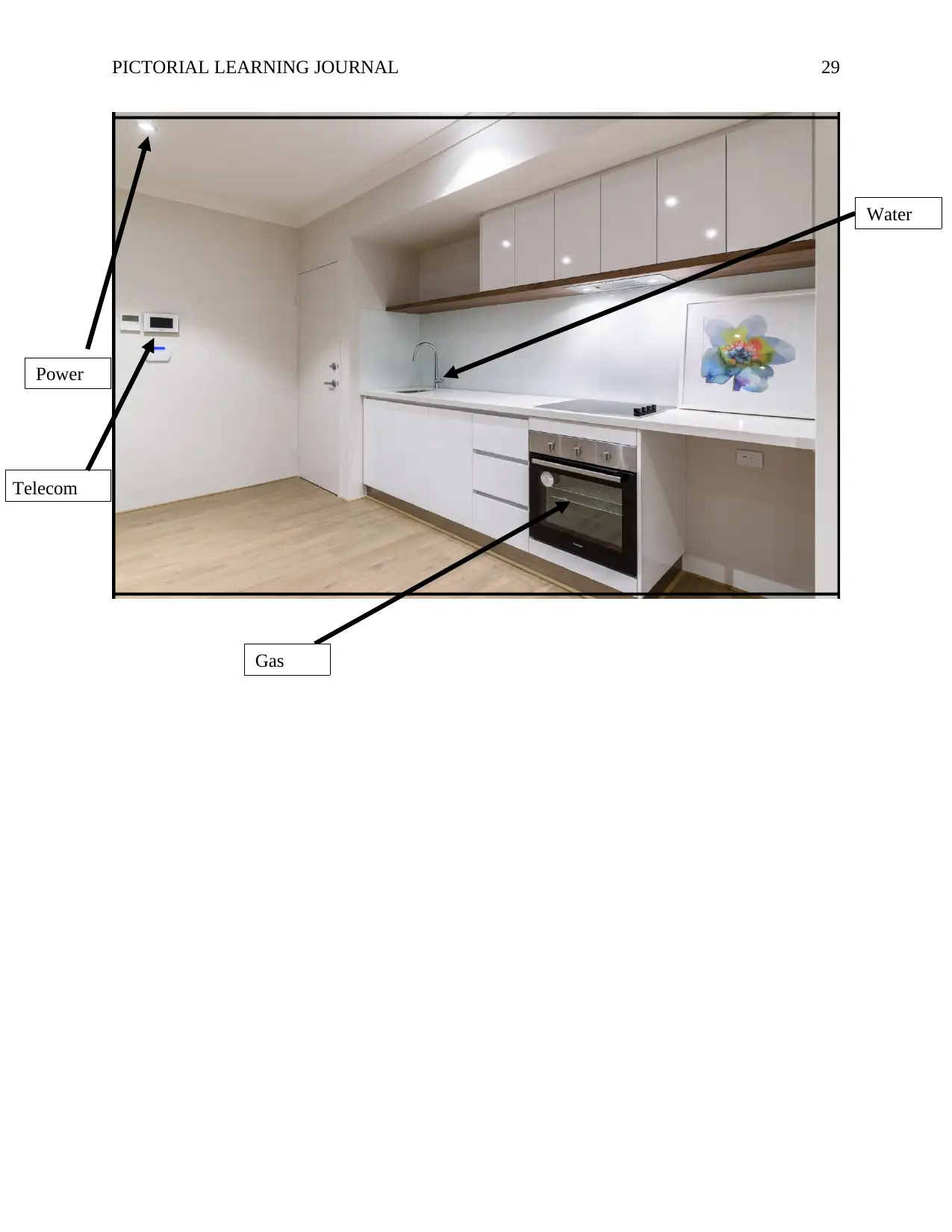
PICTORIAL LEARNING JOURNAL 29
Power
Water
Gas
Telecom
Power
Water
Gas
Telecom

PICTORIAL LEARNING JOURNAL 30
References
Basic Civil Engineering. (2015). What is reinforcement in construction. Retrieved April 21,
2018, from Basic Civil Engineering:
http://www.basiccivilengineering.com/2015/05/what-is-reinforcement-in-
construction.html
Jamal, H. (2017). Common Types of Concrete and their Characteristics. Retrieved April 21,
2018, from aboutCivil.com: https://www.aboutcivil.org/types-of-concrete.html
References
Basic Civil Engineering. (2015). What is reinforcement in construction. Retrieved April 21,
2018, from Basic Civil Engineering:
http://www.basiccivilengineering.com/2015/05/what-is-reinforcement-in-
construction.html
Jamal, H. (2017). Common Types of Concrete and their Characteristics. Retrieved April 21,
2018, from aboutCivil.com: https://www.aboutcivil.org/types-of-concrete.html

PICTORIAL LEARNING JOURNAL 31
Paraphrase This Document
Need a fresh take? Get an instant paraphrase of this document with our AI Paraphraser

PICTORIAL LEARNING JOURNAL 32

PICTORIAL LEARNING JOURNAL 33

PICTORIAL LEARNING JOURNAL 34
Secure Best Marks with AI Grader
Need help grading? Try our AI Grader for instant feedback on your assignments.

PICTORIAL LEARNING JOURNAL 35

PICTORIAL LEARNING JOURNAL 36
1 out of 36
Your All-in-One AI-Powered Toolkit for Academic Success.
+13062052269
info@desklib.com
Available 24*7 on WhatsApp / Email
![[object Object]](/_next/static/media/star-bottom.7253800d.svg)
Unlock your academic potential
© 2024 | Zucol Services PVT LTD | All rights reserved.
